Your source for the latest news on yachts, boats and more. Read through our articles to find out how to compare boats and find the right fit for you!

The best catamarans for ocean sailing/crossing
Sep 25, 2020
less than a min
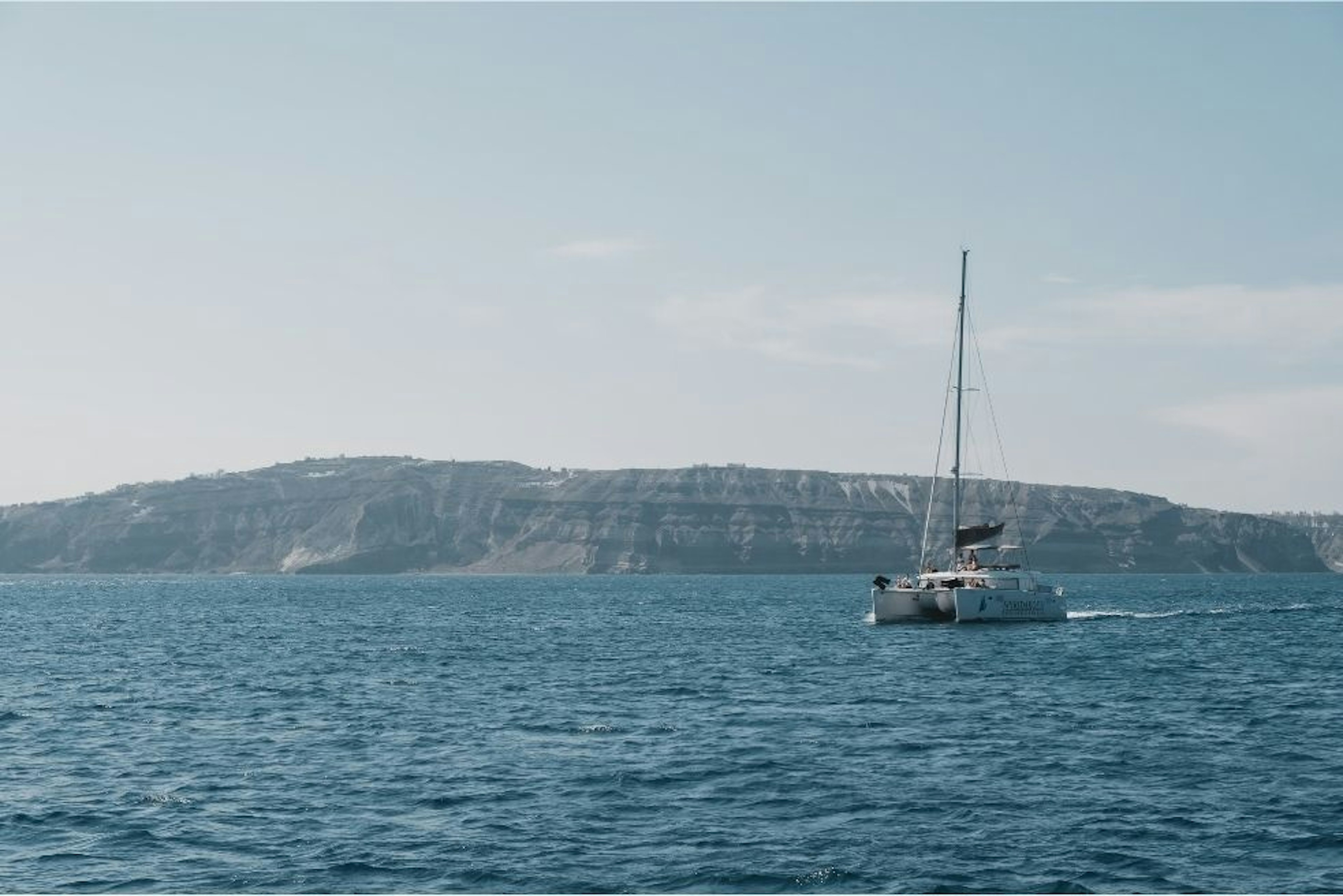
The best catamarans for ocean crossing have to embody a few key features in order to be safe for anyone on board, including guests and crew members. Most catamarans do perform quite well in open waters and are regarded as safe vessels to be offshore. This is especially true with large catamarans with big hulls.
In addition, many catamarans have sailed through horrific weather and have managed not to capsize due to their great roll inertia. What basically happens to a catamaran in a rough sea is the boat just surfs sideways when a big wave hits.
Not to worry however as in most cases, weather forecasts will determine whether a catamaran can go offshore on that specific day or not. In addition, the highest risks are when catamarans sail on a north- south axis between seasons. That said, there are a few catamarans that do perform better when crossing oceans than others.
Typically, cruising catamarans are divided into two categories:
- Charter Catamarans
- High-Performance Cruising Catamarans
Charter catamarans have fixed keels, shorter bows, forward masts, heavier displacement, high-windage flybridges, and low-aspect rudders. These boats are mainly chartered to guests and are not designed for ocean crossing rather than sailing close to shore and enjoying views in a touristic way.
High-performance cruising catamarans , on the other hand, have deeper rudders, less displacement, efficient daggerboards, a small weight and large sail plans. They are able to go at a 50-degree TWA to windward in all weather conditions, and can even outsail keelboats. In addition, when a storm hits, all that is needed is for the catamaran to sail at a higher speed and maintain balance and lower loads.
These features make them some of the best catamarans for ocean sailing.
Which is the best catamaran for ocean sailing
After getting a quick glance of what makes a multihull a good fit for offshore sailing, let’s get to the good part: which one is the best catamaran for ocean cruising ?
Technically, there are thousands of options to choose from when it comes to catamarans. So today we are going to present our choice based on the criteria mentioned above.
One of the best catamarans for ocean sailing in 2020 is The Privilege 435 . This is a long-distance, light weight cruiser produced in the Gold Coast area of La Rochelle. The Privilege 435 is a heavy-displacement multihull that has been around for almost 30 years. This is a luxurious well-built yacht with a decent proportion that allows it to cross oceans safely. It has a 23ft 2in beam, 43ft 1in LOA, as well as good proportion with a low-slung superstructure which is perfect for low wind resistance. In addition, the Privilege 435 is equipped with 4 cabins and 4 showers and costs about $300,000 to $350,000. The ample interior makes for a comfortable vessel to withstand long- distance trips.
While this catamaran sits on the high-end of the spectrum when it comes to yachts, there are many other more affordable options to choose from, if you are looking to sail offshore on a long-distance trip. Use TheBoatDB with a free account to compare other catamarans to the Privilege435 and figure out which one is the best fit for you to ocean cruise. You can even browse through TheBoatDB database to get some more options on the table. Last but not least, make sure to take into account the route and predicted weather conditions before embarking on your adventure.
You might like these too

Sailboat or Motorboat – Learn the pros and cons lg ...
Aug 24, 2022

Types of Catamaran Boats: Sailing, Power, and Luxury Catamarans lg ...
Feb 10, 2023

Which is better a wooden boat or fiberglass boat lg ...

What are the main types of sail rigs for sailboats lg ...

Which is the Best Economical Catamaran lg ...
Oct 04, 2021

What is a Chine on a Boat lg ...
Oct 01, 2021
- Outremer 45
- Outremer 4X
- Outremer 4.zero
- Outremer 52
- Outremer 55
- Outremer 51
- Outremer 5X
- All the Outremer Fleet
- Personalized support
- Blue Water Sailing Seminars
- Our concept
- The Outremer team
- Our commitments
- Construction principles
- Our catamaran services
- After-sales customer service & Quality control
- Offshore Connected Catamaran Maintenance
- Concierge Services
- Our owners’ stories
- FAQ – Outremer catamarans

- Brokerage: used catamarans for sale
- Privacy Policy
- Legal Notice
- Grand Large Yatching
Sailing around the world on a catamaran
Setting off around the world in a multihull, perhaps aboard a catamaran… It’s a dream come true! On the trade winds route, in the Atlantic, the Pacific or the Indian Ocean… Let’s discover together, in this article written with Bénédicte, owner of an Outremer 55, the most beautiful round the world stopovers not to be missed.
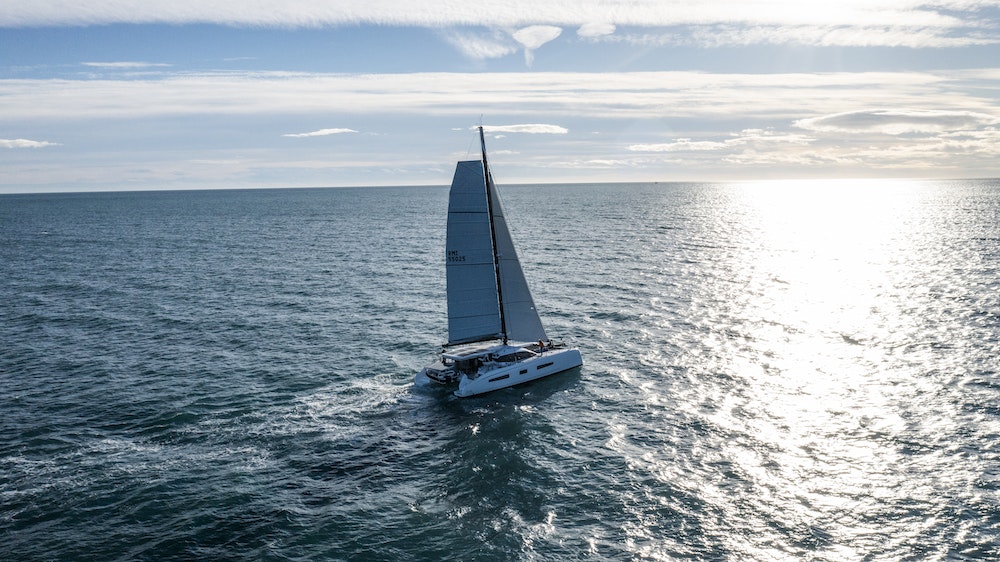
It was the expedition of the Portuguese explorer Magellan in the 16th century that led to the first circumnavigation of the globe under sail. Setting off with five ships in search of a passage between the Atlantic and Pacific oceans, the navigator discovered what would later be known as the Strait of Magellan. The explorer’s reduced squadron continued sailing from east to west around the world, and a single ship completed the circumnavigation. Three years later, he returned to his starting point in Spain and achieved the feat of the first circumnavigation by sailboat.
Even today, sailing around the world is a dream come true. Fortunately for us sailors, today’s conditions are very different and the adventure is much more accessible! It’s now possible to set off on a trip around the world fully equipped. Whatever corner of the globe you find yourself in, you can take advantage of the best instruments to help you navigate and guide you. You’ll also have the luxury of staying connected, so you can check the weather forecast, keep in touch with your loved ones and, above all, stay safe.
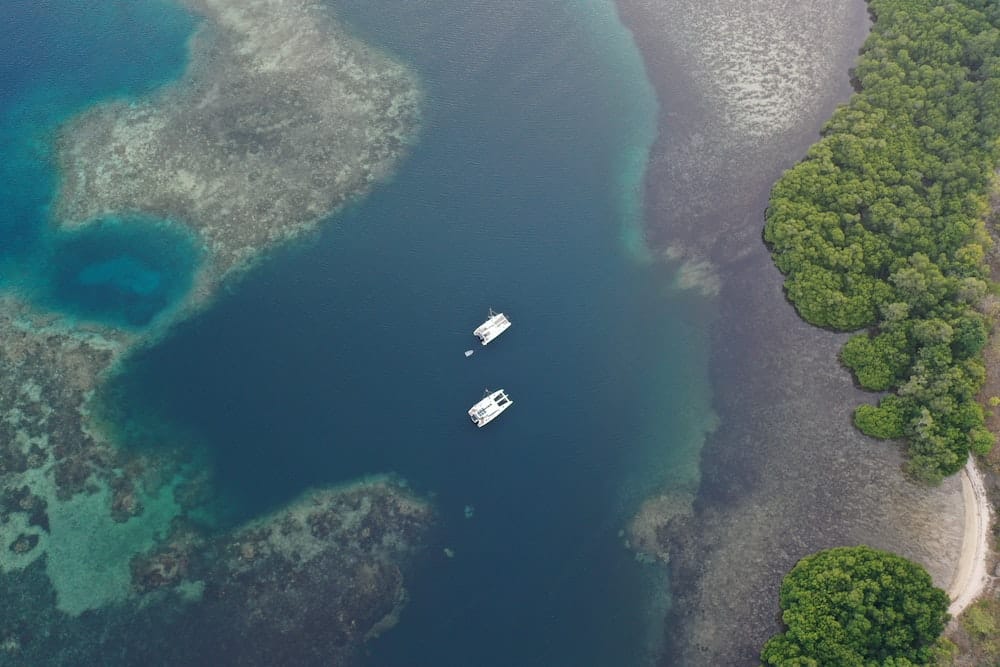
Among multihull owners, Bénédicte Hélies can testify to this! She has been on two round-the-world catamaran voyages with her husband and children, and this is not the first time:
For her first voyage – aboard the Outremer 51 #39 named Moby, the family chose to follow the trade winds. Bénédicte, Loïc, Victor, Arthur and Anna headed for the world’s most famous ports of call, to discover 32 countries and 121 islands. All this in three years and 50,000 nautical miles aboard their catamaran on three oceans: the Atlantic, the Pacific and the Indian.
For their second circumnavigation under sail, this time aboard Saga – l’Outremer 55 #1, the crew is this time opting for new stop-off points, which were not part of the first itinerary. Still sailing from east to west, the family made stops off the beaten track, which they later recounted in the blog Le voyage de Saga .
At the heart of this second adventure, Bénédicte agreed to help us write this article, sharing her best tips for a great catamaran voyage.
Read also: Meet the GLYWO 500 crew: Marijke & Mark on an Outremer 55
Ports of call on a round-the-world sail, on the trade winds route
The Trade Winds route is the classic itinerary followed by most ocean-going catamarans. It promises crews the chance to sail around the world pushed by the wind, downwind, as long as they follow the rhythm of the seasons. It’s possible to sail a catamaran from east to west, crossing three oceans and stopping off at some fantastic destinations.
Leaving Europe, the yachts and their crews generally start by making a transatlantic crossing to the West Indies. They then sail through the Panama Canal to the Pacific Ocean, where they make several stopovers. They then sail, usually via the Torres Strait, to Indonesia and then the Indian Ocean.
From here, there are two ways to reach Europe: via the Suez Canal to the Mediterranean, or around the Cape of Good Hope to the Atlantic. With this second option, crews then generally cross the South Atlantic, followed by a final transatlantic crossing from west to east, in the northern hemisphere.
The first Atlantic legs, from Europe to the West Indies
You will probably start your journey from the Atlantic coast or the Mediterranean Sea. After crossing the Bay of Biscay or the Strait of Gibraltar, you’ll head for the Canary Islands and Cape Verde. Here, you can make your first wonderful discoveries, among friendly people who are used to the passage of voyaging yachts. These destinations are renowned for their sailing sports!
Some crews then stop off in Senegal, where they can also drop off humanitarian supplies taken on board in France. It’s not just a great cruise, it’s also an opportunity to help others…
Then it’s off to the West Indies. After your first transatlantic ocean crossing lasting several weeks, you’ll be able to envisage shorter crossings, between numerous islands that are well worth the diversions. From north to south: the British Virgin Islands, Anguilla, Saint-Martin, Saint-Barthélemy, Antigua, Guadeloupe, Dominica, Martinique, Saint Lucia, Saint-Vincent and the Grenadines, the islands of Trinidad and Tobago… All these destinations promise a sunny end to the year, as well as particularly pleasant sailing conditions. You’re sure to enjoy some exotic experiences!
If you have a little time before passing through the Panama Canal, you could consider sailing to the ABC islands of Aruba, Bonaire and Curaçao, off the coast of Venezuela, which are ideal for water sports. The Cartagena region of Colombia may also be worth a visit.
Finally, before crossing the Panama Canal, the San Blas are a particularly popular destination for tour-dumondist sailors: highly renowned for sailing, the archipelago offers the chance to sail from islet to islet in idyllic landscapes…
In the Pacific Ocean, from the Panama Canal to Australia
After passing through the Panama Canal, you’ll continue to be amazed. A multitude of magnificent destinations await you in the largest ocean on our planet: the Pacific.
After exploring the Pacific coasts of Panama and Costa Rica, the Galapagos archipelago in Ecuador is a comfortable stopover before the trans-Pacific. From there, you can head for the Marquesas Islands and sail through the enormous territory that is French Polynesia, to discover all its riches!
Following in the footsteps of many other sailors, you can stop off in the Tuamotu archipelago, the Windward Islands, the Leeward Islands or, even further afield, the Austral Islands. A word of advice: allow plenty of time to get there, as the distances are great and the destinations are all magnificent… The programme is packed: discover the islands and pearl farming, snorkelling, diving and underwater fishing.
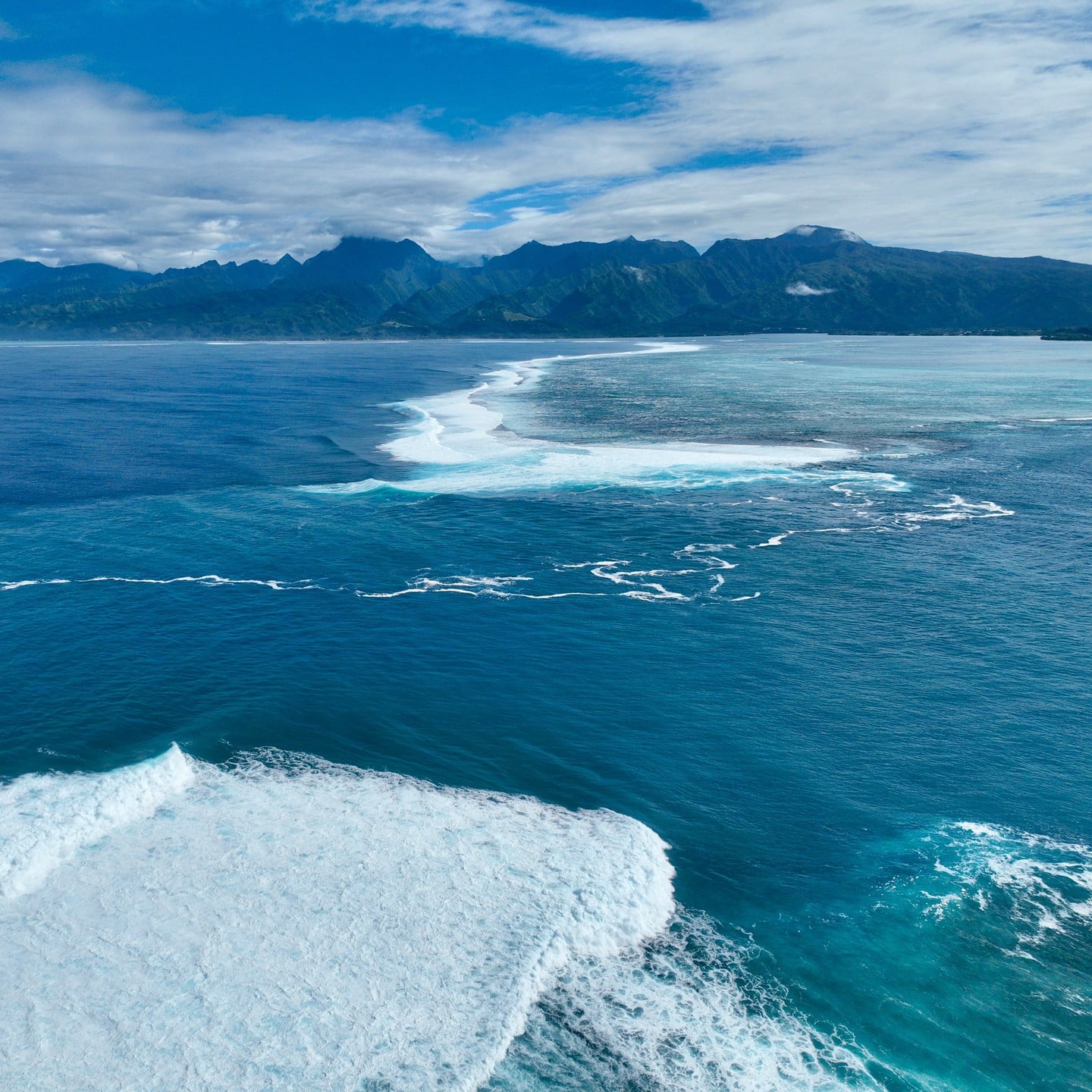
Bénédicte and her family chose to visit the Gambier archipelago: “In Polynesia, to get off the beaten track, we chose to head for the Gambier archipelago. Getting there from Panama is demanding: nearly 3 weeks at sea, at less downwind than usual, on a beam. But with a 55-foot catamaran like ours, that’s no problem. The Gambier archipelago alone is a concentration of the best of the Marquesas, the Tuamotus and the Leeward Islands. As in the Tuamotus, there are motus and a magnificent coral reef with a rich underwater fauna. We had a wonderful time, both underwater and on land! There’s a very strong culture here, with very warm values of sharing and hospitality. It’s easy to make contact, especially when it comes to bartering for the fruit and vegetables that grow in the inhabitants’ gardens, just like in the Marquesas Islands. As in the Leeward Islands, you can enjoy lovely walks and hikes in the forest, along well-kept gardens, with magnificent views from the summits. You can also visit pearl farms producing some of the finest pearls in the Pacific.”
Many yachtsmen are won over by French Polynesia. Arriving at the furthest point on the globe from France, they often feel they have found the most beautiful place on earth and sometimes decide to call it a day. However, further down the road, there are so many other wonderful destinations to explore on a catamaran!
As you continue westwards, still in the South Pacific, you’ll discover other countries and peoples that are well worth a stop. In the Cook Islands, the Samoan archipelago, Tonga and Wallis and Futuna, your sails will take you to magical places, where you’ll come into contact with people who are, once again, very welcoming. In Fiji, you’ll enjoy traditional villages and numerous spots perfect for water sports. The stopover in Vanuatu should also provide you with some unique experiences…

On the subject of New Zealand, Bénédicte confides: “Everyone thinks that it can only be visited by van, but it’s a well-kept secret that it can also be visited by sail! It offers three exceptional sailing basins, each with dozens of safe anchorages, splendid panoramas, magnificent walks and easy access to supplies. Not to mention the restaurants and vineyards!”
Finally, New Caledonia and Australia are also good stopping-off points before leaving the Pacific: as well as a change of scenery, you’ll find everything you need to maintain and refuel your catamaran before continuing your journey.
From the Torres Strait to the western Indian Ocean
While some yachts opt to sail around Australia, most take the Coral Sea and Torres Strait to reach the Indian Ocean. Explore Papua and the Raja Ampat archipelago, East Timor and the Komodo dragons, Borneo and the orang-utans, or enjoy cultural adventures and idleness in the world’s largest archipelago: Indonesia!
Some crews choose to sail all the way back to Thailand, sometimes leaving their boat in the town of Krabi for a while.
One of the little-known destinations on our westward journey is the small Australian archipelago of the Cocos (Keeling) Islands: a stopover in the Indian Ocean that Bénédicte describes as “very interesting from every point of view” . She remembers an excellent anchorage, a magnificent stretch of water for wingfoiling, a pleasant and friendly beach, and some great snorkelling sessions. On the neighbouring islet, which is inhabited, there are also plenty of opportunities for cultural visits! After that, the journey continues, sailing across the Indian Ocean to Mauritius, the Maldives, the Seychelles or Reunion Island. For Bénédicte, Mauritius should be much more than just a stopover: “It’s the traditional stopover on a crossing of the Indian Ocean, where the boats think about stopping off, content to stay in Port Louis. It’s true that it’s a nice stopover, with the Caudan marina, its large open shopping arcade, its museums, its lively market, its restaurants… But Mauritius can also be visited by sail! On two occasions, with both Saga and Moby, we sailed around Mauritius, stopping at various anchorages: on the east coast, at Trou d’Eau Douce – which gives access to Ile aux Cerfs, Mangénie islet, Mahébourg – an old colonial town – and Blue Bay marine park; on the west coast, at Rivière Noire – which gives access to Gorges park – and Tamarin, with its surf beach and magnificent sunsets. Finally, to the north, Grand Baie and the surrounding area offer lively, beautiful beaches and several other pleasant little anchorages.”
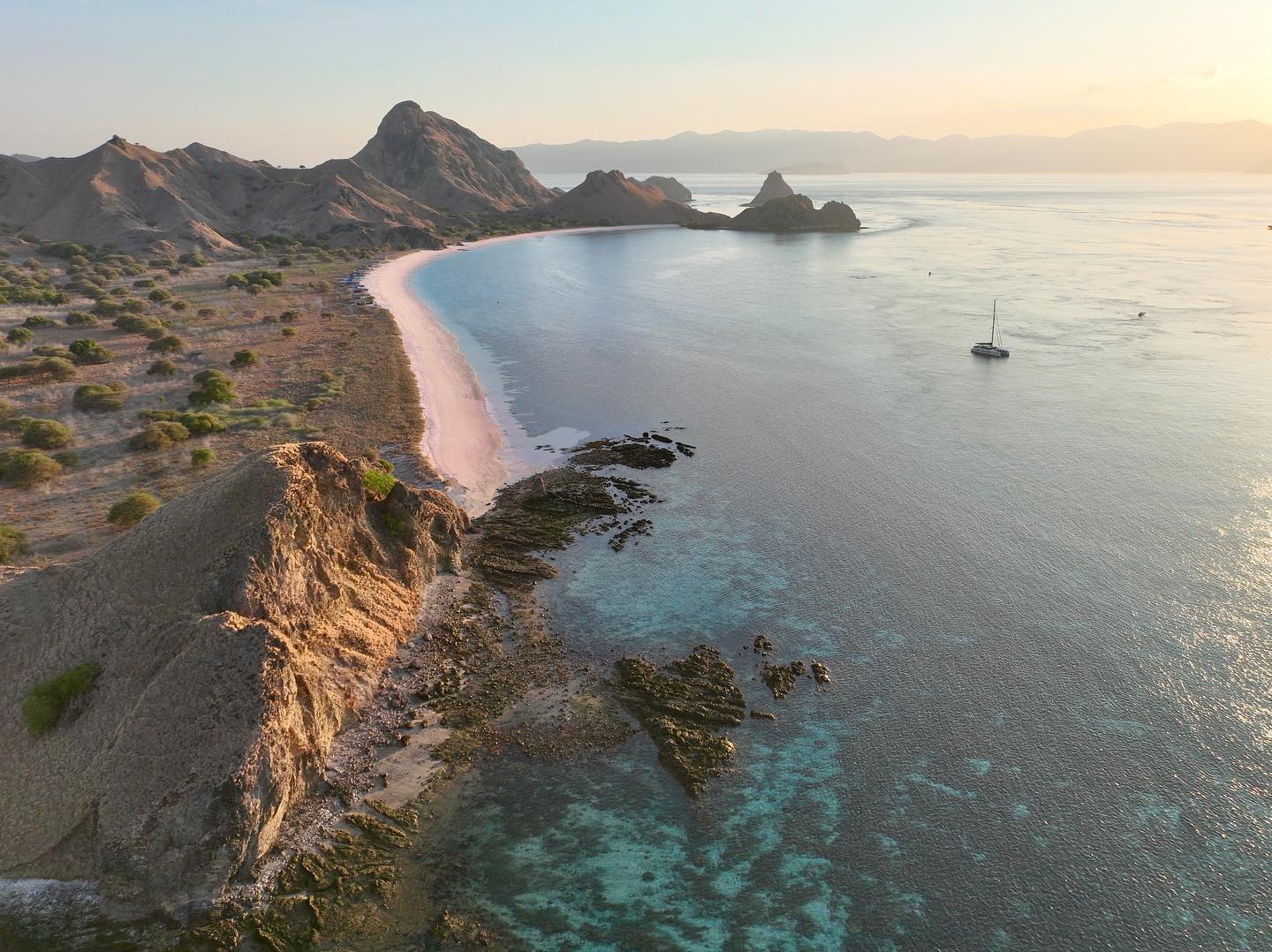
As well as this well-known destination, the yachtswoman recommends visiting other territories in the Indian Ocean: “The Chagos Islands, for example, are a nature reserve teeming with birds and fish! There are thousands of coconut crabs, frigate birds, dolphins and dolphinfish in the inner lagoon, as well as a wealth of underwater life. You can spend a maximum of three weeks here, with permission. And it’s a privilege to witness such a wild and abundant nature”. The deserted archipelago of Saint-Brandon is also well worth a visit: “It’s a well-known destination for yachtsmen from Mauritius and Reunion, where you’re guaranteed a change of scenery! It’s a semi-enclosed atoll made up of dozens of islets of varying sizes, renowned for its seabed and fishing. When it comes to board sports, it’s paradise: there are exceptional kitesurfing and wingfoil spots, wild beaches with rare shrubs and thousands of birds.”
n the end, Rodrigues is a small island with an old-fashioned, tranquil atmosphere, which the traveller still recommends: “We spent ten fantastic days sailing there. The island is very welcoming and offers two anchorages: in town, at Port Mathurin, and at Port Sud-Est. The first offers a very pleasant stopover with a market and small restaurants. The second is a spectacular anchorage on the inner edges of the channel, with direct access to the lagoon and ideal spots for wingfoil and kitesurfing.”
Bénédicte insists that, for her, the Indian Ocean’s great cruising destinations are poorly known and largely underestimated. For her, the Indian Ocean is an “exceptional sailing destination on a catamaran”.
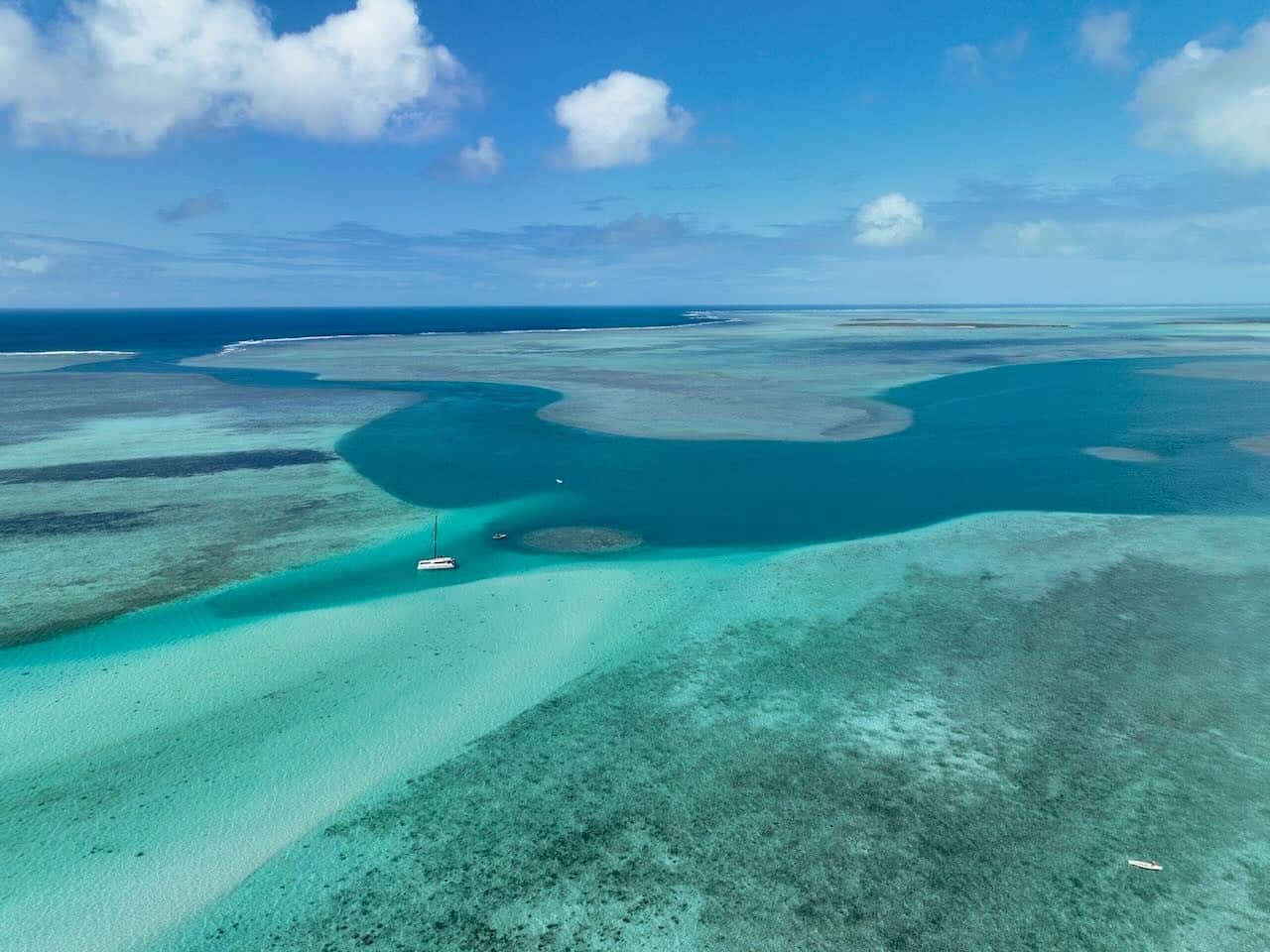
After visiting these destinations, it’s already time for your final stopovers in the Indian Ocean. Depending on the stopover points you have chosen and whether or not you wish to use the Mozambique Channel, you will make a stopover in Madagascar or Tanzania, or head straight for South Africa.
This country will be a compulsory stopover – but also a very pleasant one! – before your second Atlantic crossing: the stopover in Cape Town will allow you to prepare the boat for one of the last ocean crossings, in a port where everything is easily accessible. Here, you can wait comfortably for the right “weather window” to cross…
Sailing back to Europe from South Africa
You will cross the South Atlantic Ocean from east to west. On this occasion, you may make a stop on the territory of Saint Helena. But where to next?
In the Western Atlantic, before returning to Europe, you may be tempted to make the same stops as on your first passage. But if you want to see more, your round-the-world catamaran trip could be the perfect opportunity to visit some new destinations! Brazil, the Bahamas, Bermuda and the United States, for example, are still waiting for you.
Finally, for your last ocean crossing, the return Atlantic crossing, you will undoubtedly stop off in the Portuguese archipelago of the Azores. There’s no doubt you’ll meet other crews who, like you, have sailed around the world in a catamaran. It’s the perfect opportunity for us to look back together at all these beautiful stages…
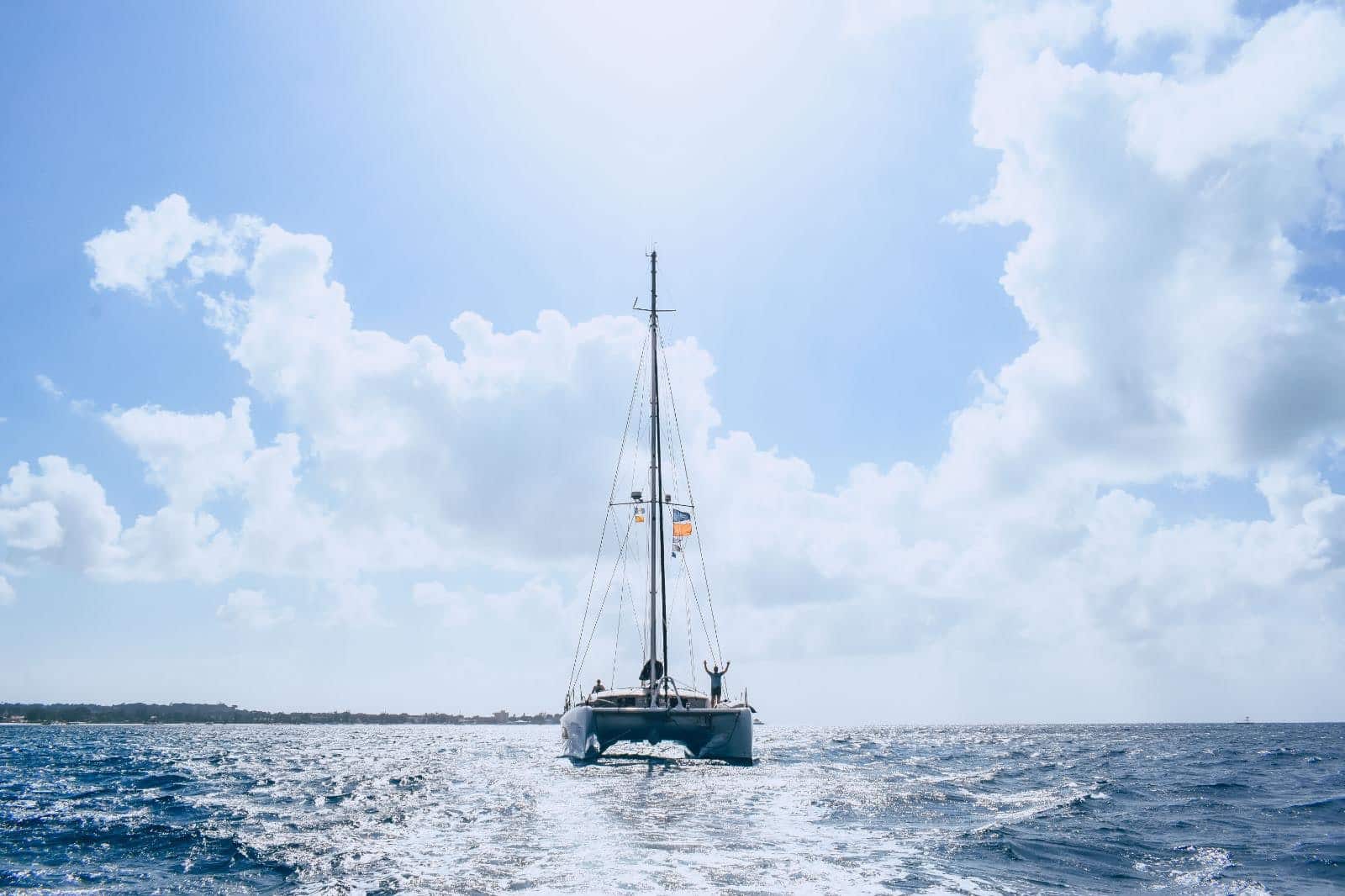
Gone are the days of the great explorations. You probably won’t have the chance to discover unexplored lands by sailing around the world on a catamaran these days. On the other hand, by choosing stopovers off the beaten track, you’re sure to feel like an adventurer! Just what you need to make your round-the-world sailing experience unforgettable…
Read also: Working remotely and sailing around the world: David and Inês are living the dream onboard their Outremer 5X
Continue navigation
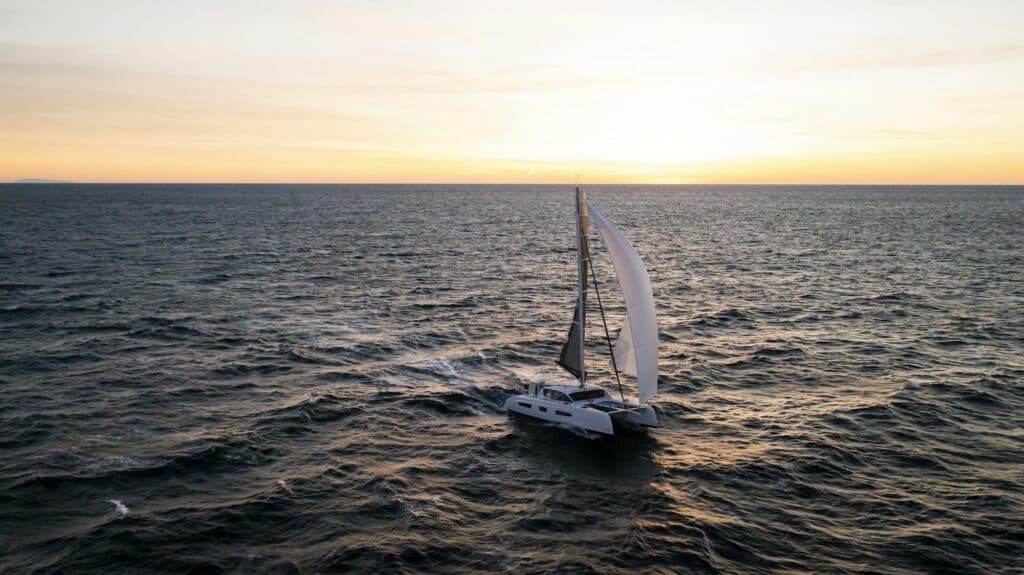
Why sail around the world in a catamaran rather than a monohull?
Sailing around the world is a dream come true: you discover the world to the rhythm of the wind and the stopovers, exploring new destinations every day as you sail. If you’re just starting to read this article, you’re probably nurturing this project. Are you planning to sail around the globe? Then the choice of ship for your next voyage is crucial.

The Importance of Defining Success
In the Autumn of 2023, I ran a ‘Webinars for Women’ mini-series on transatlantic preparations. The first session was titled: “How to approach transatlantic preparation.” As I zoomed out of the nitty gritty of canned food recipes, spare parts inventories, and preventative sail repair and took a broader look at the framework for a successful crossing, I homed in on what I think the first and most important step is: defining your goal.

Sailing in the Bahamas : unforgettable stopovers
The Bahamas Islands are a dream destination to explore under sail! In the heart of the Caribbean Sea, the archipelago offers the chance to enjoy sailing through splendid scenery, pleasant places to stop off and memorable activities. In this article, the Outremer team tells you what they consider to be the essential stages of a catamaran cruise in the Bahamas.
- Find Us On Facebook
- Find Us On Instagram
- Watch Us On YouTube
- Find Us On LinkedIn

Good Cat, Bad Cat
What is wrong with this picture.
What’s missing is the bridge deck clearance! The single, most important factor is the load carrying capability! This affects everything else. Find out more below…
Good Cat, Bad Cat! What Do We Mean By That?
We don’t mean a boat is bad quality, or doesn’t sail well. What we’re talking about here is what makes a catamaran well suited for long distance cruising with a good sized load aboard. What makes a boat suitable for extended stays aboard.
This page was put together from interviews with builders, designers, delivery captains, owners, charterers and from our own personal experiences delivering boats up and down the East Coast, offshore and vacations aboard with both experienced and inexperienced catamaran sailors. It’s both practical and technical. The information is not intended to support any particular product, though we obviously have chosen Fountaine Pajot because we believe it is a good example of our discoveries. Many people get referred to this page by other dealers and owners.
Let’s Take a Look
Please read all of this document‐there’s some really great stuff at the end‐don’t short change yourself!
Why It Matters…
The sun doesn’t always shine. The seas aren’t always calm. Find out why it’s important to have nets forward that let the waves through. Those are lighter and reduce pitching. Why load carrying is so important for safety, comfort and for you to accomplish your goals. And much more…
For Charterers…
The information provided here shows the difference between a comfortable boat and a disappointing vacation. Sure, in protected waters most anything will do. But if you’re planning on chartering in the Caribbean‐‐this is information that will make a difference in how well you enjoy your vacation!
For Used Boat Buyers…
Many of the older boats literally got away with murder! There was no competition. Much has been learned. New technology has perfectly matched the needs of catamarans to be light, but strong. Use these criteria to choose the best compromises if you simply can’t go for the latest and best.
For New Boat Buyers…
Surprise, Surprise. This is the age of spin doctors and marketers. What looks good at boat shows, isn’t necessarily what will make a serious, offshore cruiser. Many, so called, new boats are actually re‐hashes of very old designs‐‐sometimes 10 years old or more. Often with a couple of feet slapped on to the transom! Buyer beware! You will find information here that will narrow the search.
Learn how to offset 80% of the costs of a new yacht with tax advantages and income here .
What Are You Doing For The Rest Of Your Life?
It all depends on what you’re planning to do! Staying at the dock, venturing out for weekends in protected waters? More ambitious? Coastal cruising? Or are you combining coastal cruising and watching the weather, with serious offshore cruising? Your plans affect what you need and you need to plan for the most adventurous cruise you plan.
How do we know what’s required? Because we arrange delivery of many boats every year‐‐trans‐Atlantic, and East Coast to the Caribbean. We talk to the captains who have sailed all kinds of boats. We’ve talked to the designers. Visited the plants. What I’m sharing with you here is the distillation of 100’s of hours of talks based on hands on experience with some of the most knowledgeable sailors out there in all conditions.
This discussion is directed towards offshore sailing. But even if you only want the capability, here is where you’ll find out about what to look for. Remember, even if you don’t plan to venture into long distance cruising, the person you eventually sell to may want to so your selection now, may affect your boat’s resale later. Why cut off any market potential? A “Good Cat” can sail inshore AND offshore.
Looking at What’s Important… Good Cat, Or Bad Cat?
Is it built for inshore or offshore sailing? With the advent of new technology the high tech necessary for ocean cruising catamarans is now affordable. The appeal of comfortable sailing without healing, of privacy only attainable with good separation of living and sleeping spaces, and a panoramic view with extraordinary deck space‐‐not to mention shoal draft… Catamarans have come of age. (If one has any doubts, he simply hasn’t visited a boat show lately!)
As with any new phenomenon, there are plenty of promoters anxious to jump on the latest trend‐‐whether they know anything about what’s required or not. This paper is designed to highlight the 4 important distinctions that will help you understand the builders’ intent. Is he offering an inshore or offshore Cat? The 4 important criteria to consider (aside from overall quality and integrity) are:
- Stability. Beam to Length ratio and Static Stability
- Pitching. The comfort factor
- Bridge Deck Clearance
- The Control Cockpit. Flybridge or deck-level?
Load Carrying Capacity
There are other factors we’ll be discussing as well and I urge you to pay particular attention to #4‐all of the others hinge on this being right first.
A catamaran generally has no ballast. It primarily depends on beam and individual hull buoyancy for stability. The wider it is, the more stability‐‐however, at some point excessive beam becomes unmanageable. In addition a narrower hull is more easily depressed and prone to tripping in heavy seas. The same wider body hull that gives you better load carrying ability, also gives you more total stability. Of course at some point, you lose performance… Finding the balance is the key.
Virtually all of the experienced builders, especially the European builders who must sail their boats transatlantic to their bases in the Caribbean, have settled on a minimum length to beam ratio (L/B) of approximately 50%. That’s a 20′ beam on a 40′ boat. As the boat gets larger, over 50′ or so, you can back off from this ratio a bit and still have adequate stability. These same experienced builders put enough beam into the individual hulls to give more than adequate load carrying ability. One sign of an older design (often resurrected these days and promoted as new) is narrow individual hulls, sometimes supplanted by (needed) extra beam because the hulls no longer have the required buoyancy.
(By the way, you can often recognize these designs from inside because the berths will be high and spanning the bridge deck‐‐the hulls don’t have enough volume to carry 4 full size double berths! Watch out!)
Static stability is a measure of a boats stability. The factor was developed by sign builders (what strength wind will blow our sign over?!) A bad cat (for offshore) might have a static stability in the 25 knot range. A good Cat in the 50‐60 knot range. This is a static measure. In reality, the boat would slide sideways and round up if you were foolish enough to leave all sail up and this would approximately double the figure.
Imagine two children on a sea‐saw. If they’re both near the center of rotation:
- It’s very difficult to get the board going at all. And if they did and you came by, you could grab the end with two fingers and stop them. Imagine the same two children moving out to the end of the board.
- Now it’s easy to get the board moving (pitching). And once the children got started, you wouldn’t want to try grabbing the end to stop them‐you would probably get your hand broken!

Pitching can make your life miserable. Tire you out so you take unnecessary chances. Dampen your appetite. However, solid decking forward does more than just contribute to pitching. In offshore conditions when you might be semi‐surfing down waves; your bow can overtake the wave system ahead of you and plunge into the wave. Nets simply let the water through and allow the bows to recover. Solid decking can trip the boat and cause a catastrophic pitch pole‐mid‐ocean. Netting forward rather than solid decking is crucial for an offshore cat‐for comfort and for safety!

Good Cat Left…
Long overhangs fore and aft. Accommodations concentrated in center of boat (weight kept out of the ends). Beam/Length ratio 58%, Static stability about 55 knots.
Bad Cat Right…

By the way, the last thing you want to do is have decking and/or footwells forward. The extra weight forward is bad enough, but if the foot wells and lounges fill up with water when you surf down a wave at sea, for instance, you can have real problems.
Did you know that if you measure these forward wells there can be up to 100 cu. ft of water-catching, enclosed foot well? A cu. Ft of water is 7.48 gallons. A gallon weighs 8.5# (62.4 pounds/cu.ft.). So 100 cu. ft of water combined with additional structure means you could easily add 7,000 lbs of water forward when your nose dips into a large ocean wave. Think about it this way. That’s like carrying a Pick up truck on your bow when you’re sailing offshore. (Okay, if you’re just chartering in a 50 mile circle–but is this how you want to sail offshore?)
Bridge Deck Clearance
This is generally referred to as the height from the water to the underside of the nacelle. If it is too low, waves will slap and bang under the living accommodations. Sometimes literally knocking the plates off the table in a poor design. The noise prevents sleeping. But I amplify this view. When I talk about bridge deck clearance I want to be sure there is adequate volume for smooth passage of seas between the hulls and also that the separation between the hulls isn’t exaggerated.
Imagine pushing two pipes through the water as in example (Cross sect. A&B). The pipe with the small hole must create much more resistance; literally forcing a wall of water before it. Pipe A easily allows the water through.
You need the combination of:
- the highest possible bridge deck clearance
- Adequate beam between the hulls‐‐but not too much distance
- and smooth transitions between the nacelle and hulls…
…to allow the smooth transition of waves with minimum resistance, impact and effect on forcing the bows up into the start of pitching motions.
Catamaran Bridge Deck Clearance Example
A good cat, left, has a higher bridge deck clearance, with no protuberances interrupting the water flow. The wider beam between the hulls also contributes to uninhibited water flow between the hulls.
Note the difference for the bad cat on the right. We have heard this as one of the biggest negatives from owner’s who owned boats like those on the right. This is also one of the biggest reasons for them selling. (This style is typical of many of the older generation of boats, and also some new ones where marketing types take over from the designers).
Why not too much beam? Have you ever observed the wake coming off the bows of a boat? (Actually if you watch a power boat, the effect of a heavier boat at higher speed exaggerates the effect I’m talking about.) The wave curves up and away at an angle about 150 degrees back from the bow. If you measured diagonally outwards from the bow, you would see that the wave increases in height as it curves away from the bow. Keep this in mind.
Now, imagine an older design catamaran with narrower hulls (The waterline beam of each hull being narrow.) The hulls don’t have the buoyancy to give the stability that comes from buoyancy (see above) so the designer is forced to gain stability the only way he can‐‐he increases the overall beam. The trade off? Several and all bad:
- The two bow waves come together under the nacelle as they angle back from the bow and the distance is longer (with the wider hulls) so the wave is bigger‐‐the result is excessive pounding under the bridge deck! In other words, the self generated waves combine with even a modest chop causing pounding in relatively moderate conditions.
- The narrow hulls don’t give you the load carrying ability a serious cruiser needs.
- The narrow hulls don’t allow the berths to nestle comfortably (and low) in the hulls, forcing berths to be uncomfortably high and overlap the bridge deck in some way in order to make them full size (or allow the charter company to advertise king sized beds!.
- Being so far apart, the hulls sometimes sail in two different wave systems imparting a very uncomfortable motion.
Why would anyone design a boat this way? The answer is that today they probably wouldn’t. However some charter companies or marketing companies trying to take advantage of today’s catamaran popularity, and wanting to keep costs down choose older designs whose tooling cost is already amortized (or choose inexperienced designers) primarily to reduce the cost of the boat. The problem is that a bad design will always be a bad design and the cost will long be forgotten while the discomfort will linger…
Remember, charter companies ask designers for parameters suitable for people staying on‐board for short times and equipment (load carrying capacity) needs are minimal for these short times. These boats, typically only need to sail in a 50 mile circle.
Whether you’re looking to use our investment program to pay your boat off early, or getting it for some serious cruising we take the long view. We represent up to date designs that feature boats with the load carrying ability you need for care free, serious cruising (This is my only advertising plug in this piece, but I feel I’ve given you enough information to earn the right.)
This may be the most important point of all. It’s not just that the boat goes slower, when you immerse the extra hull depth, the boat gets sluggish. It won’t come about without turning the
engine on. It is difficult to maneuver in tight situations or when docking. This hull submersion also decreases the bridge deck clearance, which promotes hull slamming as well! What a shame‐‐because a well-designed catamaran should be a joy to sail in all conditions and much easier to maneuver than a monohull with it’s widely spaced twin engines.
When you sail offshore you will carry 1,000’s of pounds of extra water, fuel, stores, safety equipment and amenities. (Whether you plan to or not, consider resale value‐‐the next owner may want the option!) Here’s what manufacturers do for marketing, which reduces load carrying capacity:
- Install inboards in too small a boat, or in a boat originally designed for outboards.
- Start with a performance hull and try to make it all purpose (too narrow a waterline beam). (Or, as mentioned above, simply start with an older design, narrow hull with deep “U” sections.)
- Put in too many accommodations (charter boat!)
- Build the boat too heavy‐Use low tech construction. Needless weight in the building takes away from load carrying.
Some dead giveaways. At a boat show, look at the lower transom step‐‐especially when there are a number of people in the cockpit‐ ‐ is the step awash (actually underwater?) Not enough load carrying. Is the waterline at the water (or below it) at either end or entirely? Not enough load carrying. Sure, you can move it up, but believe me, that doesn’t solve the problem!
NOTE: We had the Fountaine Pajot Salina 48 above, recently at a Blue Angels exhibition in Annapolis. over 50 people, full tanks, full equipment and catering for 50 aboard. Note, the waterlines on both sides are still well above water! A good cat! P.S. note Blue Angels in back round. Maybe next time you’ll be there!?
The central nervous station–the control cockpit

1. The boom has to be higher to give headroom. Much higher. Out of reach for tucking in the sail or handling tangled lines. It greatly raises the center of effort of the sail plan introducing increased jiggling motion, and compromising safety in heavier air.
2. The helmsperson is out of touch with the cockpit. Beverages, food, conversation–all require participants to negotiate steps.
3. Helmsperson is not at deck level–not in a position to help with docking maneuvers–incomparable with short-handed (couples) sailing–a charter boat affectation.

Whether you actually go offshore or not, you may meet bad weather conditions. Your comfort, enjoyment and safety, (and ultimately resale value) are dependent on proper design.
Most of the criteria I have shown here, you can easily evaluate yourself. If what others tell you doesn’t make sense, or if what I tell you doesn’t make sense, then make your own evaluation. There’s no magic here. Good design really does make sense and you can see the telltale signs.
A Test…Putting Together What you Know
Look at the boat from the transom. Are the individual hulls narrow (is the transom narrow)? Is the bridge deck clearance low? Are the hulls too far apart? Or too close together? Are the transoms already in the water with no overhang showing (overloaded aft)?
- Look at the boat from the side. Is the boat, while lightly loaded, already on her waterline or below it!? (There should be several inches of hull showing below the waterline!
- Inside. Are the berths spanning the hulls?
- The bridge deck? About right? Why?
- Service. Can you get to the engines? Easily? At sea?
- Are accommodations pushed into the ends?
- Is there a net forward? Substantial overhangs with no weight in the ends?
Senior Sales Consultant, Partner [email protected] 410-703-5655 More from Eric >> Boat Business Webinars, Videos, Blogs, Learning center and more.
ESE, LLC is completely responsible for the content in this document. The reader is responsible to verify any information he desires to validated based on the information or links provided here.
Notice of Use of Cookies
We use cookies and similar technologies to recognize your repeat visits and preferences, as well as to measure the effectiveness of campaigns and analyze traffic. To learn more about cookies view our Privacy Policy . By continuing to use our site, you consent to the use of cookies.
Yachting World
- Digital Edition

The best bluewater multihulls of all time: a complete guide
- Toby Hodges
- October 6, 2021
Toby Hodges and François Tregouet consider the best bluewater multihulls and look at the options for sailing the oceans in spacious comfort

What are the best bluewater multihulls for long term cruising? The one you own, or the one you can afford is the simple answer.
There is a wealth of proven designs to suit bluewater sailing and a variety of budgets. While we have focussed here on the best bluewater multihulls in production, we’ve also included some cracking pedigree multihulls which tour the planet and might occasionally pop up on the brokerage market.
If you can afford to, then pushing towards the 45-50ft length will buy you space, pace and that extra payload capacity needed to take all the items you’d want on your home afloat.
When looking at the best bluewater multihulls, the choice will come down to that perennial balance between comfort/space and speed/weight. Choosing a lighter weight performance design will obviously help you cover distance voyages more rapidly and potentially allow you to outrun weather systems. It means you can sail faster, with less sail up and less load and stress. But you’ll have to sacrifice some luxuries and need to be quite scrupulous about keeping weight down and centralised in order to maintain high average speeds.
For the majority of cruisers, however, it is the amount of space multihulls offer once you’ve reached your destination that really appeals. As well as the non-heeling living area and real estate they provide, they’re well suited to typical tradewind sailing .
If you’re considering your first or next multihull, we hope the following will serve as a taster.
Best bluewater multihulls for performance cruising
Outremer 51/55.
When you think of multihulls designed for bluewater cruising, Outremer will likely be one of the first names that comes to mind. Its heritage lies in building catamarans that can sail fast and are built strong enough to do laps of the globe.
The 51, the current version of which launched three years ago, is an archetypal example of what to look for in terms of blending speed and space is a dream design for a family circumnavigation.
The French yard’s new 55ft VPLP design may look boldly different from its past models, but the philosophy behind it remains the same. It is designed to match windspeed up to 12 knots and Outremer reasons that its ability to sail in 5 knots of breeze will allow it to sail for 95% of the time on a circumnavigation.
Read more about the Outremer 51 and Outremer 55.

Photo: Diego Yriarte
Seawind 1600/1370
For nearly four decades the Australian Seawind brand and its founder Richard Ward have been gearing catamarans around safe bluewater sailing, including performance, protection and ease of handling. Its Reichel Pugh-designed 1600, which launched three years ago, is an elegant looking cat with relatively low, long lines and some smart solutions for fast bluewater sailing.
Seawind also launches its new 1370 later this year, a staggering 60 of which have sold on plans alone.
This first 50 is built from a composite sandwich of basalt fibre, a cloth made from volcanic rock, and PET foam from recycled plastic bottles, which helps to reduce carbon emissions by nearly 50% when compared with traditional glassfibre methods.
This new 50 footer is perhaps a more appealing and practical prospect than Rapido’s previous 60 (with its significant fixed beam), particularly as the amas on this new model can fold to reduce beam to 18ft.
Infused carbon foam sandwich construction is used, along with beams, daggerboards and rudder in pre-preg carbon to keep displacement to 8,200kg.
Read more about the Rapido 50
This OC50 is designed as a more affordable cruising alternative, than the HH models which have preceeded it. This model targets ocean sailing.
It’s still stiffened and strengthened by carbon, but built in vinylester composites with a gelcoat finish. This adds an additional 300kg or so over a full carbon HH50, but cost savings are in the region of $400,000.
Read more about the HH OC50
Balance 526
The 526 launched four years ago, designed to suit short-handed sailors and families looking to sail long distances, hence it can carry large payloads and promises easy maintenance. It looks good too.
Berman’s Versahelm design is a key feature. The wheel cantilevers, allowing the helmsman to steer from outboard with clear sightlines or from the hardtop protection of the aft cockpit.

Photo: Christopher White
Atlantic 47
The A47 suits short-handed fast ocean sailing at an approachable size. Lengthening it to 49ft allowed for an aft cockpit. It is available as a sloop or with White’s patented MastFoil ketch rig – rotating aerofoil masts designed for easy short-handed cruising without sacrificing performance.
Read more about the Atlantic 47
A combination of sharp design from François Perus and high build quality brings plenty of appeal to this sporty Italian-built cat. The first example launched three years ago with a light displacement of 10.5 tonnes, thanks to an E-glass epoxy-infused build with carbon strengthening. The yard offers semi-custom construction and full hybrid packages.
Catana 53/Ocean class 50
Catana’s performance model from 2017, sports twin aft helms (which may not suit ocean sailors), reverse bows and carbon daggerboards. The high topsides help create good bridgedeck clearance and plenty of accommodation. Its new Ocean Class 50 seems more in the shipyard’s bluewater DNA. The light weight, and dynamic and modern shape with slim hulls and a relatively short nacelle suggests a seaworthy nature and high speeds.
Read more about the Catana 53
Best bluewater multihulls for pedigree performance
Veteran multihull designers Morrelli & Melvin designed this smaller model for the Gunboat range. It was built to be more manageable for an owner-driver yet still capable of up to 300-400 mile days.
The Gunboat 48 is something of a rare breed, just six 48s were built between 2004 and 2009. Oh, to have a spare €1.3m right now… one of them is actually on the market.
Read more about the Gunboat 48
At the start of the Millennium, Catana offered fully equipped boats as standard for long distance cruising. The Catana 471 or 472 (one or two helms respectively), represented at the time the optimum in ocean-going catamarans.
Chincogan/Lightwave
Tony Grainger has been drawing fast multihulls for 35 years, including racing trimarans and the Lightwave and Chincogan cruisers. The popular Lightwave 38 has admirable performance and comfort, and the Chincogan 52 (pictured) has the length to clock high average speeds.
Outremer 45 G. Danson
With its characteristic roof, narrow hulls and daggerboards, the Outremer 45 is a standout design which has become somewhat iconic. Despite a rather spartan interior, it has been a great success with fast cruising enthusiasts. On board, family ocean crossings at an average of 10 knots are the norm.
Best bluewater multihulls for family cruising

Photo: Nicolas Claris
The Lagoon 450 remains the most popular model in Lagoons already popular range. It exemplifies the VPLP/Nauta design partnership which has made these the very definition of modern mid-size cruising catamarans which can appeal to families and charterers alike.
Indeed the 450 marked the modern look of Lagoon and was the first with interior styling from Nauta. It originally launched over a decade ago as a flybridge design with central helming position (450F), before this ‘sport top’ option (450S) was offered with a starboard helm station and lower boom.
Read more about the Lagoon 450

Photo: Guilain Grenier
Fountaine Pajot Saona 47
The 47 has a modern shape, with straight bows and a reverse sheer line. It incorporates significant volume in the hulls below the bridgedeck to create room for the optional athwartships cabins. Cabin space is a prime selling point, particularly the owner’s suite to port, where there is also abundant natural light and headroom.

Photo: Tui Marine
Leopard Catamarans, together with designer Simonis Voogd and builder Robertson and Caine, produce the archetypal dual-purpose owner-operator or charter boat in their modern catamaran range.
Key features of the 45 are the amount of light in the saloon and the incredible volume and space on offer in the cabins above the relatively narrow waterlines. Vast social living areas include the flybridge, saloon and dual cockpits.
Read more about the Leopard 45

Photo: www.jfromero.fr
Nautitech Open/Fly 46
During the 1990s and noughties Nautitech earned a good reputation for its elegant catamarans. The 441 is a timeless example and the 44 can be credited with the ongoing trend in hardtop biminis. While its acquisition by Bavaria seven years ago helped Nautitech implement industrial build techniques, the French brand has retained its DNA at its Rochefort sur Mer yard.
The modern Marc Lombard designs have tall rigs with generous square-top mainsails. Twin wheels in the aft quarters of the Open 46 offer a direct feel on the helm, however those spending long periods in the tropics may prefer the shade of the bimini-equipped flybridge option. The layout is also open, with a saloon more outside than in. Styling is clean, modern and simple, and the standard of build and finish are good.

Photo: Olivier Blanchet
First impressions of the Neel 51 are sure to centre on its sheer size and space inside. But as you’ll see from our review of the Neel 43 on page 83, when you sail one overriding impressions quickly centre on its performance.
These trimarans are becoming a popular mass production-built option.

Photo: Christophe Launay
The Excess 11 packs plenty of potential as the smallest yacht offered by the big production yards. A little like the Lagoon 380 of old, it presents a good value new entry-level boat for genuine cruising in a more sporty, modern and enticing design. Some may argue against aft helms for ocean sailing, but those coming from monohulls will appreciate the more direct steering they offer.
Broadblue 385S
Broadblue is a UK brand which offers a distinct line of cruising and Rapier performance catamarans. Its staple 385 packs a lot of cruising comfort into its length, including generous tankage, and has been sailed all over the world. Broadblue built its first electric drive catamaran 12 years ago and offers the only all-electric production sailing catamaran under 40ft in Europe.

Photo: Christophe Breschi
Bali Catspace
For those looking for maximum volume within 40ft, it’ll be hard to beat the Catspace – although it is more of a holiday apartment than a traditional bluewater cruiser. Bali’s garage style sliding aft door does help offer an enormous amount of enclosed (or open) living space.
Best bluewater multihulls for luxury cruising

Photo: Nico Krauss
Privilège 510 Signature
The 510 is designed to take a serious amount of cruising gear – up to six tonnes of it in fact. The excellent helm station now has a fixed windscreen and all lines lead to hand. Finish quality including the electrical installation is first class and Privilege’s trademark, an admirable full beam (26ft) forward cabin, is sumptuous.

Photo: Jérôme Houyvet
Garcia Explocat 52
Garcia Yachts has cornered the market for series-built aluminium monohulls and multihulls in the last decade and this new Explocat 52 is sparking real interest. We ran a full test report in our February issue, describing it as a go-anywhere cat with an enticing combination of space, pace and rugged construction.
Read our review of the Garcia Explocat 52
Built in Argentina, the Antares 44 is the ultimate evolution of a model launched 21 years ago. Entirely dedicated to bluewater cruising, it is the yard’s only model and is constantly being improved according to owner feedback.
Time seems to have no hold on this boatyard and, against the trend, the standard equipment of the Antares 44 is extremely complete

Photo: Richard Langdon
Discovery Bluewater 50
This luxury Bill Dixon design may be a decade old now and into its third iteration, but the concept behind its original appeal remains. For those used to sailing high-end thoroughbred monohulls, here is an option to consider for a comparative level of build quality and fit out when moving to a multihull.
Read more about the Discovery Bluewater 50
St Francis 50 MKII
With this latest version of its original model, this experienced South African builder has optimised a catamaran cut out for the unforgiving seas of the Indian Ocean and the South Atlantic. The MKII allows for an increased load capacity, an important point in long distance cruising.
Xsquisite X5
Intelligent features on the X5 include the protected helm station with glass windscreen, integrated rainwater catcher, UV-protective glass and generous tankage.
Best bluewater multihulls for size & speed
Mcconaghy mc52.
The MC50 (now MC52) was the first and promises some high speed sailing, but it’s the open plan main living deck which will attract the majority. It incorporates an intelligent centreboard system, which hardly affects interior space, but arguably its exposed helms at the aft end of the flybridge will not suit serious ocean cruising.

Photo: Florian H. Talles
HH in Xiamen is building some really impressive large, luxury fast cats up to 90ft. This was its second model to launch, a high-end, high performance Morelli & Melvin design capable of rapid passagemaking speeds and enjoyable regatta sailing. Features include C-shaped boards and central or aft helms.

Photo: Mike Jones/Waterline Media
Ocean Explorer 60
If Nautor’s Swan made catamarans, they may look like this… The Ocean Explorer 60 uses the same designer in German Frers and some of the same builders who worked at the famous Finnish yard to produce this world cruiser. The resultant quality shines through. A new OE72 is due soon.
Kinetic KC54
A young company with plenty of experience, Kinetic produces custom fast ocean cruisers, which can occasionally race. Its 62 is a serious performance vessel with carbon hulls, rigs and rigging, daggerboards or centreboards. With fast bluewater cruising the goal, carbon is used to minimise weight so features/toys can still be added. The swim platform and hardware on the newly launched 54 weighs just 90kg, and the generous sized tanks are all in carbon too. Views from the saloon and forward cockpit also look special.
Best bluewater multihulls for ultimate performance
Marsaudon ts4/orc 42.
Few catamaran builders produce genuine performance cruisers at this ‘smaller’ size: this one is kept minimalist and light weight (around 6 tonnes) – the yard’s philosophy is ‘simplicity, then add lightness.’ The 42 is a cruiser-racer with the ability to outpace most yachts across the Atlantic, win a regatta and still offer some space for island hopping. Standard tankage is minimal however. Marsaudon recently rebranded its TS range to Ocean Rider Catamarans (ORCs) and has an ORC 57 in build.
Dazcat 1495
Dazcat builds fast, seaworthy cats from its Multihull Centre in Cornwall. The 1495 is a true ocean cruiser-racer, which is stiff and rewarding to sail, with direct steering linked to carbon rudders. The 1495 can hit 20+ knot speeds with relative ease, but it is the consistent high average speeds which will attract those looking to cover serious miles. Weight is centralised including engines, tanks, and systems all located amidships to help reduce pitching. Dazcat has a semi-custom build approach and creates all sorts of weird and wonderful craft for all abilities.
Dragonfly 40
Dragonfly trimarans are known for their high quality construction and ability to delight sailors with their ease of planing speeds. For those who can live without the space of similar length cats, the new flagship 40 is large enough to offer cruising space, while folding outriggers and retractable appendages mean you can dry out where others wouldn’t dare.
Looping 45/Freydis 48
These two designs by Erik Lerouge both offer a high-performance vision of ocean cruising. The Loopings were built individually and the Freydis in small series, and on both you can sail as fast as the wind in complete safety. Interior quality depends on whether finished by an amateur or by a shipyard.
Swisscat 48
An attractive combination of luxury, comfort and performance, the S48 is a stiff, go-anywhere premium cat that is easy to manage single-handed. The lightweight build (11t) is in epoxy infusion with carbon reinforcement.
Schionning Designs
Jeff Schionning has catamaran design in his blood. His designs exude performance and seaworthiness with flowing, even aerodynamic lines. On all tradewind routes you’ll find a G-Force (models from 12m to 23m) or an Arrow (12m to 15m) sailing more quickly than the rest. His latest venture is with Current Marine in Knysna, South Africa.
Best bluewater multihulls for pedigree cruising
The long-time best-seller from the world leader in catamarans, with more than 1,000 produced over almost 20 years from 1999. With its characteristic vertical windows, the 380 and its big brother the 410 made the purists scream when they were presented. But the 380 proved a pioneer of its kind. Safe bow volumes and light displacement (7,260 kg) helped its seaworthy behaviour. The high number of boats on the market makes this the most affordable bluewater cruising multihull for its size, even if price range is as wide as condition is variable.
Casamance 44/46
Between 44ft and 46ft depending on the year of construction and the length of its transoms, the Casamance was an impressive catamaran on launch in 1985. The design by Joubert/Nivelt offered good volume and load capacity. Of the 490 units produced, many joined the charter fleets. The exterior of the Casamance is dated, but the interior in grey ceruse oak has retained plenty of charm.
If you enjoyed this….
Yachting World is the world’s leading magazine for bluewater cruisers and offshore sailors. Every month we have inspirational adventures and practical features to help you realise your sailing dreams. Build your knowledge with a subscription delivered to your door. See our latest offers and save at least 30% off the cover price.

Catamarans In Rough Seas? Facts and Figures From Sailors!

As an Amazon Associate, we earn from qualifying purchases. We may also earn commissions if you purchase products from other retailers after clicking on a link from our site.
I had my first “real” sailing experience 11 years ago on a monohull in the Bahamas, before that I worked at a Ferrari workshop. Coming from a “dry-land-racing” world made me wonder why some would argue that cats are unsafe in rough seas. They should be more stable since they have a wider base, just as in the racing world, right? A few years later I still hear this old statement that catamarans arent safe for rough weather, so today ill try to add some info on the topic.
Catamarans are safe in rough seas because their double-hull design and wide stance make them highly stable. They’re also easy to maneuver, have shallow drafts, and high speeds that help them outrun storms. Still, you need a skilled crew capable of controlling the vessel to ensure your safety.
In this article, we’ll explore several reasons why catamarans are safe in rough seas. We will also take a deeper look at what makes catamarans capable of handling rough sea conditions. Keep it here to discover valuable tips on how to sail your catamaran safely despite the weather.
Table of Contents
Catamarans Are Practically Unsinkable
A capsized monohull might right itself up, but guess what? A well-designed cruising catamaran is very hard to capsize and almost impossible to sink. This doesn’t mean that it’s okay to go looking for storms to conquer, though. So, what makes a catamaran so difficult to sink, even in the unlikely event that it flips over? Let’s find out.
If you want to dive a little deeper into Catamaran capsize statistics I suggest my other article: Why catamarans capsize!
Catamarans Are Highly Stable
In rough seas, a catamaran will show its superior performance through its twin hulls. Rough seas are defined as waves that rise to heights between 2 to 6 feet (0.6 -1.8 meters).
The hulls turn a catamaran into a floating platform that’s pretty sturdy. In addition, their wide stance and solid construction make the vessel extremely stable, allowing it to withstand the water’s constant pounding motion. The larger the boat, the more stable it gets.
The result is a smooth ride with minimal to no rocking from wave action. As a result, you are less likely to suffer from motion sickness on board a catamaran. A stable platform means reefing and sail changes become much easier and safer, particularly during rough weather. You suffer less fatigue and are thus more alert. Furthermore, there is minimal risk of anyone suffering severe injuries or falling overboard.
Cats Are Easy To Maneuver
Catamarans manufacturers employ various design and structural techniques to enhance maneuverability. Firstly, the bridgedeck positioning is above the water to create a high bridgedeck clearance , which contributes to a ride that is free from loud noises called bridgedeck slamming. Something that old school cats had problems with and would prematurely fatigue the crew.
Read this article to understand what makes a great blue water catamaran (a cat that’s design for rough seas)!
Secondly, catamarans are lightweight vessels, making it easier to steer and control them. Therefore, if you get caught up in rough weather, you are more likely to be able to handle the waves correctly and safely.
In addition to the double hulls, cats also have dual engines , making it easier to maneuver the vessel in and out of tight spots. This feature is particularly useful when you need to escape an oncoming storm and find shelter in a crowded marina. What’s more, if one engine fails as you try to outrun a storm, you can always rely on the second engine to get you to safety.
As mentioned earlier, an alert crew is essential for vessel safety in all weather conditions. And since catamarans are easy to maneuver, crew fatigue becomes a lesser issue, allowing you to sail from rough seas to safety.
It’s also easy to learn how to sail a catamaran , even as a new sailor. As a result, you will be more comfortable with your boat, promoting more straightforward navigation in rough waters.
How long does it take to learn to sail a catamaran? Check this out!
And if you want to get started right away I suggest signing up for two free lessons with NauticEd
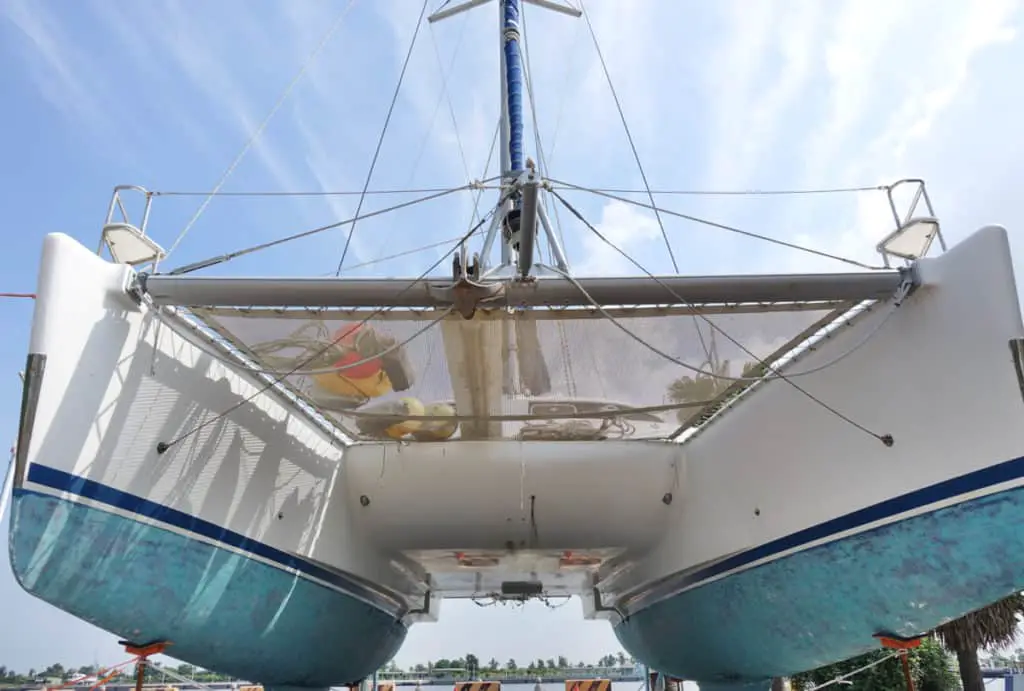
Catamarans Have Less Draft
Because catamarans rely on the buoyancy from their twin narrow hulls (instead of one wide hull on a monohull), they can handle a shallow draft without hampering either their stability or maneuverability. Cats also spread their weight equally between the twin hulls, which allows them to sit much higher on the water.
A shallow draft means a catamaran has more shelter options when bad weather is imminent . You can also anchor your boat much closer to the shore where it’s relatively safe.
You can actually park your cat on the beach, something that is referred to as “ beaching “.
They Are Incredibly Spacious
You might be wondering how ample space has anything to do with safety in rough seas. Let me explain. Catamaran layouts are well-thought-out, with spacious rooms being a major consideration. As a result, most areas, including the cockpit, main saloon, accommodation quarters, and galley, are exceptionally cozy. This enhances sailing comfort and also allows for 360-degree saloon views, which greatly improves visibility for the helmsman.
Another benefit is that there’s ample storage space, and all the sailing gear and equipment have a home. So, your gear is well-organized and stowed away carefully without crowding every available space. In rough seas, it helps the crew and anyone else on board avoid potential injuries from flying gear.
A large storage capacity also means larger fuel supplies. This is important, especially during rough weather as the engines work harder to motor through the strong currents hence they require more fuel.
Catamarans Do Not Heel
As mentioned earlier, ocean waves don’t affect catamarans as much as monohulls because, unlike monohulls, these boats don’t heel or roll (or at least not as much). This is why it’s easy to take a stroll either on the catamaran deck while under sail. The lack of heeling also makes it easier to handle the boat.
Still, due to the wide bridge deck fastened between two hulls, heavier seas could generate slapping or pounding sounds while underway (see bridgedeck clearance).
Check this article out to understand bridgedeck clearance!
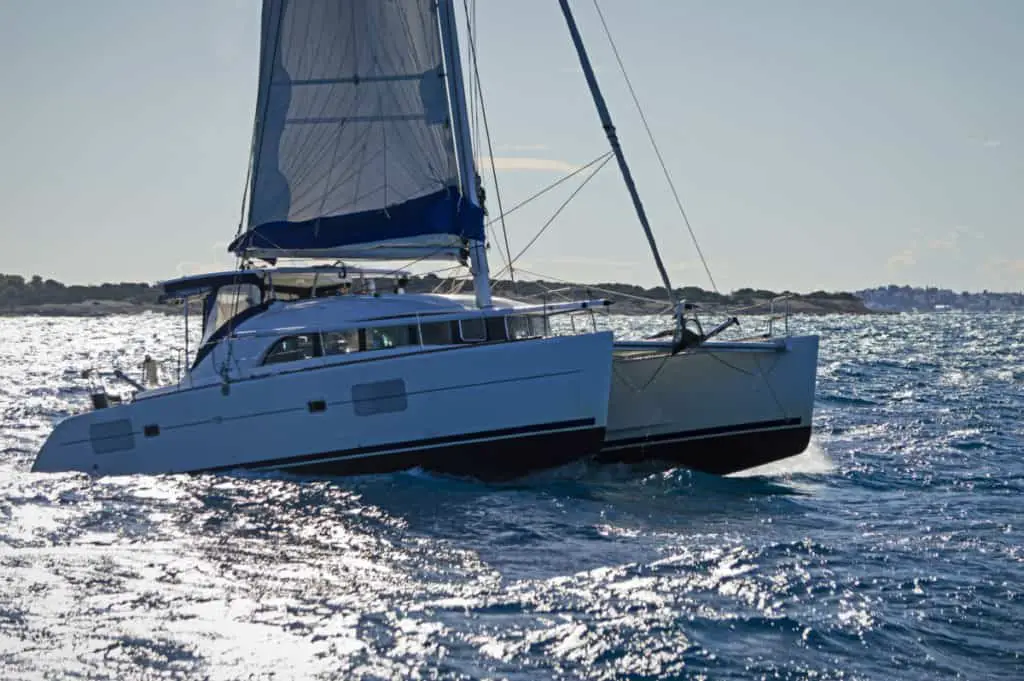
Catamarans Have High Speeds
The best way to keep your vessel safe is to avoid bad weather . But this is not always possible as you could still get caught up in a storm – despite the availability of weather reports. Fortunately, because catamarans are light, they deliver impressive speeds that you can count on at such times.
Fast speeds mean you can escape rough seas by outrunning storms and bad weather.
Cruising cats attain an average speed of 9 knots (10.5mph) while sport cruising cats can reach upwards of 30 knots ( 35mph). Also, performance cruising catamarans boast narrow waterline beams , generous sail plans, and centerboards that make them sail way faster than average cats.
Which Is Safer in a Storm; Catamaran or Monohull?
If comparing similar-sized vessels, a catamaran is much safer in rough seas and storms than a monohull.
This is due to several reasons:
- Catamarans have a larger platform: Because of its large and wide base, a catamaran is more stable and can withstand pounding waves much better than a monohull.
- Catamarans are faster. You are more likely to outrun rough weather in a cat than a monohull since its design enables it to sail much faster. Besides, the higher speed allows you to cover extensive distances in minimal time. This enables you to navigate through heavy sea conditions waters much more quickly or evade them altogether.
- Catamarans are easier to maneuver . Double engines make it easier to maneuver a catamaran in and out of tight spots, such as when getting into a marina or steering across small inland waterways. Monohulls, on the other hand, have only one engine, which could lead to trouble in case of engine failure during a storm.
- Catamarans have less draft. As mentioned earlier, a catamaran will sit much higher on the water than a monohull hence it can sail with ease on shallow waters. During a storm, it has more shelter opportunities and can pull anchor closer to the beach and away from the rough seas.
- Catamarans are not likely to sink. While a capsized monohull would right itself owing to its lead keel, a catamaran wouldn’t. Nonetheless, because of the positive buoyancy, a capsized cat would not sink, which isn’t the case for a monohull. The crew in a capsized catamaran can therefore wait for help onboard the floating vessel.
Are Catamarans Safe for Ocean Crossing?
Catamarans are sea-worthy vessels capable of making long sea passages. Larger catamarans are exceptionally safe for ocean crossing since they have lots of buoyancy and great roll inertia. They can sail through fairly uncomfortable conditions and handle strong winds without taking much of a beating.
Furthermore, the boats are not likely to capsize even when breaking waves hit them as these merely cause them to surf sideways.
Lastly, a cat’s ample storage capacity also means that it can carry enough fuel, water, and food for the passage . Hence, you need not worry about running out of your supplies in the middle of the ocean.
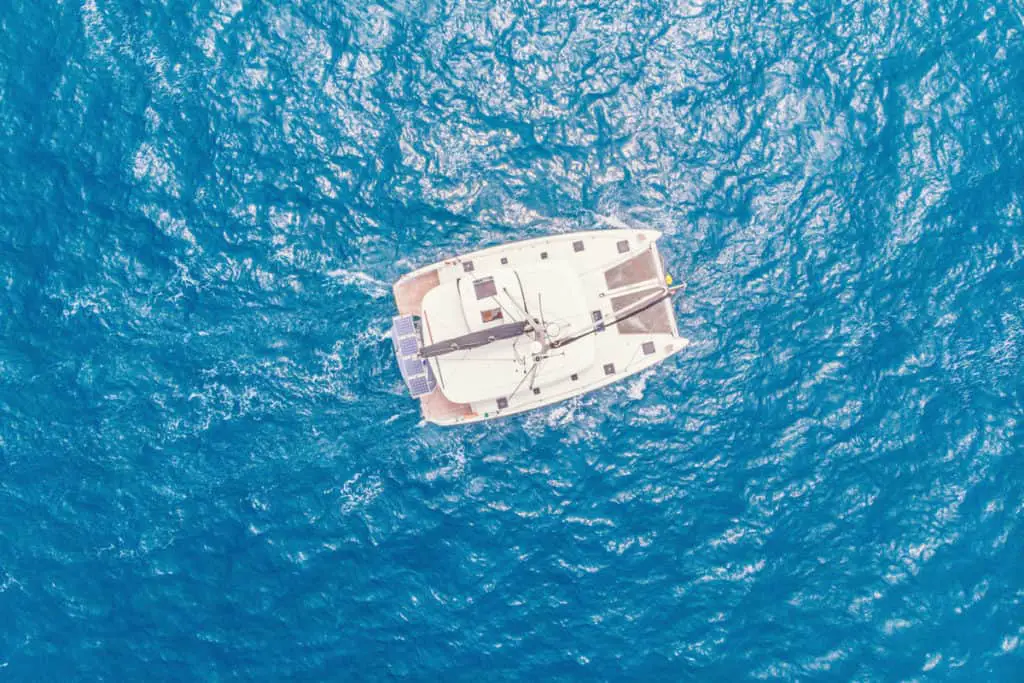
Do All Catamarans Perform the Same Way in Rough Seas?
Depending on catamaran design, performance will vary, a small boat (below 40ft) will be slower and react more to waves, a larger catamaran (+45ft) will move faster and be less impacted by heavy seas and strong winds.
In general, a vessel’s seaworthiness boils down to the construction quality, seamanship level, and boat design.
Nonetheless, high-performance cruising cats can sail windward faster than the best keelboats. Featuring efficient daggerboards, deep rudders, plus less displacement and windage, they deliver a good performance windward in all kinds of weather.
And since these catamarans are light in weight and contain ample sail plans, you need to pay special attention to your sail choice to maintain safety in all weather conditions.
But not all catamarans behave like high-performance cruising catamarans. Therefore, you need to have a deep understanding of how your boat operates before you set off into the open sea. This is only accomplished through spending time on the water.
Tips on How To Sail Safely in Rough Seas
There are fundamental safety measures as well as storm tactics. These are essential when sailing in any weather, but more so if you get caught up in rough seas.
- Undergo training. Get sufficient training on basic sailing and what to do in the event of an incident at sea. Basic safety drills are also important, and all crew should know the specific location of all life-saving equipment.
- Find out details about the expected weather. Make sure you are able to get updates while under sail, either through satellite or mobile network.
- Have the right protective equipment. Always have protective gear on board, including life jackets and vests, close at hand. Set up the boat with the appropriate safety lines and attach yourself to the same. Crew members should carry a knife, strobe, and whistle as well.
- Avoid putting your catamaran on the direct path of breaking waves (beam reach). Instead, opt for a course that places both the wind and high waves either ahead or behind the beam. Minimize the chances of a wave crashing across the deck by tacking in relatively smooth water.
- Park your catamaran. If the storm gets too intense, consider parking ( heaving-to ) your cat. This will give the boat some break from the windward pounding.
The specific storm strategies you need to use will crucially depend on the condition of the sea.
I would recommend you read the book Multihull seamanship ( amazon link ), the graphics are lame but the book is very informational, it walks you through procedures such as heave-to and what to do in case of emergency.
For additional tips on how to maintain the safety of your catamaran in rough seas, watch the video below:
Frequently Asked Questions
Should i run my catamaran straight downwind or angle it away from the waves.
It’s better to run downwind but at a slight angle since this will help increase the effective catamaran length by offering its diagonal distance to the following seas. The slight angle allows the bows to bury less, keeps the hull stable, reduces the risk of pitchpoling, and also makes it much easier to follow the sea.
How Much Sail Should I Use in Rough Seas?
When facing rough conditions it’s best to go with a minimal sail area (such as a storm jib). Minimal sail helps to calm the vessel, which makes autopiloting relatively easier. This means that you might not need to handle the helm, leaving the autopilot to do its work.
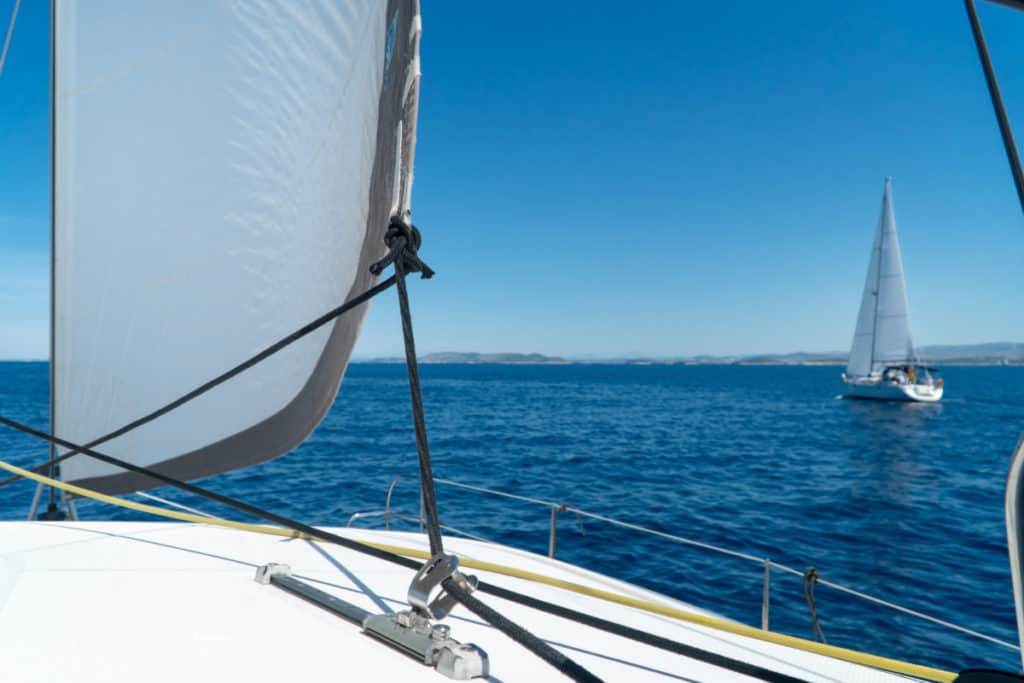
Does a Catamaran’s Length Affect Its Ability To Survive Rough Seas?
Yes, it does. A catamaran with a long waterline handles high winds and towering waves better than a small cat. The easier motion facilitates crew maneuvers, while the high boat weight increases resistance to tossing and rolling caused by the wind and waves. In addition, the higher speed helps in running from the storm.
What´s the perfect size cat for ocean sailing?
What Can Cause a Catamaran to Capsize?
A huge wave to the catamaran’s beam or surfing down a wave and burying the bows in the next wave, making it frontflip or pitchpole. To better understand catamaran capsize I suggest you read my scientific approach to understanding capsizing here .
Final Thoughts
Sailing in rough seas is a true test of seamanship. I used to be afraid of the seas, now it has become my friend. Maybe it will be the same for you! Take care!
Owner of CatamaranFreedom.com. A minimalist that has lived in a caravan in Sweden, 35ft Monohull in the Bahamas, and right now in his self-built Van. He just started the next adventure, to circumnavigate the world on a Catamaran!
Leave a Reply Cancel reply
Your email address will not be published. Required fields are marked *
Save my name and email in this browser for the next time I comment.
Recent Posts
Must-Have Boat Gear for Catamaran Sailors!
Sailing is probably the most gear-intensive activity I've ever done; there are so many decisions to be made about what gear to buy now, for tomorrow, and what to definitely never buy. The gear on...
6 Best Trailerable Trimarans For Bluewater and Coastal Sailing
Having a boat costs a lot of money, even when you are not using it, marina fees, etc. And once it is in the water most sailors never go very far from their "home marina" and sailing will be somewhat...
Call Us (561) 445-5664
How to Sail a Catamaran: 10 Catamaran Sailing Tips
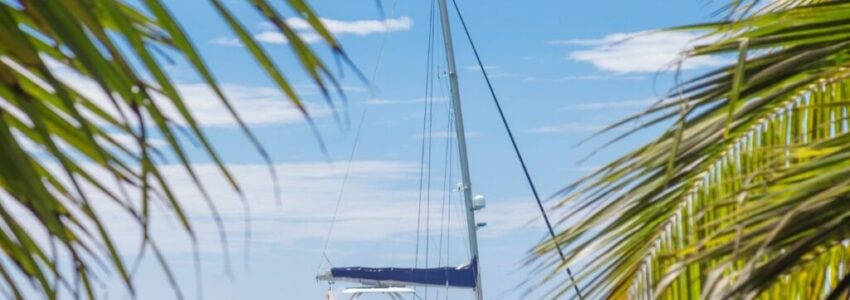
Published Sept 6, 2021
Have you been wondering about how to sail a catamaran? Well then, you’re in the right place as we will provide you the basic information about catamaran boats as well as their advantages and disadvantages. The information we’re about to tell will help you sail your catamaran as easily as possible. Lucky for you, this article includes 10 tips for sailing catamaran boats that you should know.
What Is A Catamaran?
A catamaran is a multi-hull, meaning it has two connected hulls with two engines, two sails, and two rudders. Catamarans are known for their stability and spaciousness. Additionally, they offer larger areas for the deck, saloon, and galley, so this boat is the best option for people who prioritize their comfort over the cost.
Advantages Of Catamarans
- Spacious – Catamaran is a multi-hull, so the space it offers is double the space on usual monohulls . Massive space means more space for bigger rooms, cockpits, and decks. In addition, this multi-hull can accompany more guests all at once.
- Stability – Since a catamaran is built of two hulls, they are more stable, unlike other boats. As a result, multihulls are less prone to rocking and heeling, suitable for guests or crew members with seasickness. In addition, the stability of catamaran boats makes it more comfortable for people to sleep, read, and wander.
- Easy to maneuver – Catamarans consist of two engines and rudders. They are helpful when it comes to maneuvering and docking the boat. In addition, having two engines makes catamarans reliable when emergencies occur.
- Speed – As mentioned earlier, catamarans don’t have kneels, making them lighter than other boats. This makes them faster when it comes to sailing downwind or broad reaches.
- Design – Catamarans’ designs look attractive to the eyes. These multihulls bring prestigious vibes that most guests look for. They are treated like luxurious vessels because of their fascinating looks.
Disadvantages Of Catamarans
- Expensive – Catamarans tend to be more costly than most monohulls or cabin sailing yachts. This kind of boat is more expensive because it provides many features that require more high-quality building materials.
- Availability – Despite being more expensive than other boats, catamarans seem to be very popular these days. Unfortunately, this multi-hull sells out fast, so they are not always available. If you wish to use catamarans, you should book a reservation for your boat early.
Requiring bigger space to berth – Since they provide more space for guests, it takes up as much space. Therefore, this multi-hull usually takes up double the space to berth than monohulls. . (Related: Trimaran vs. Catamaran: Which is Better? )

10 Catamaran Sailing Tips
Here are some tips on how to sail your catamaran:
1. Always keep the boat sailing downwind
Sailing downwind prevents pounding and slapping sounds that slow down the boat. When the low bridge deck slaps on the undercarriage of the boat, it causes annoying sounds. Making sure that you are sailing downwind as much as possible makes your sailing hassle- and noise-free.
2. Speed up before tacking
You must have enough boat speed to tack smoothly. Tacking refers to a changed direction of a boat to achieve the desired destination. If you don’t speed up, you will most likely not be able to tack.
3. Bring the mainsail close to tack efficiently
You can tack efficiently by keeping the mainsail tight and sailing as close to the wind as possible. You must be able to do that without losing boat speed. Otherwise, you won’t be able to tack.
4. Use the jib to help the bows turn better through the wind
Jibing is the opposite of tacking. It’s a sailing maneuver wherein the boat turns its stern through the wind to turn the bows. You should let the jib get backwinded for a while to fix the position of your bow.
5. Bring as many snubbers as you can
Snubber is short cordage attached to the anchor chain and a strong area on a boat together with a bridle. These are used to stop chains from rattling on the bow roller. Snubbers are helpful to prevent and relieve tension on lines and deck fittings. Since the ocean waves can bring pressure to many lines in your boat, you should set up as many snubbers as possible.
6. Use throttle control for maneuvering in normal conditions
The throttle control manages the speed of a boat which makes it ideal to use for maneuvering. You must do this while keeping the steering wheel center.
7. Use engines only when maneuvering in narrow spaces
For maneuvering in tighter spaces, you should consider using the engines only. Using your engines alone is better than maneuvering with steering wheels.
- Use both engines for backing
When your catboat needs to anchor, your two engines will be helpful to you. You can use both engines for faster backing to anchor.

9. Make sure that your boat has completely stopped when you’re going to anchor
Catboats have a shorter keel than most boats, so they are less resistant to water. Catamarans require more time to slow down than monohulls, so you need to be extra mindful when anchoring your boat.
10. Plan advance for weather conditions
Checking the weather when you’re planning to go boat sailing is a must. Even though the weather reports tell you that it would be a sunny day, you should still prepare for other weather conditions. You should be ready and have every piece of equipment needed if ever the rain decides to fall unexpectedly.
Cruising Catamarans
These are the types of cruising catamarans that can be used for your next sailing trip:
Charter/cruising catamarans
This type of catamaran is built explicitly for the charter market. This has small rudders, heavier displacements and can easily struggle even in ideal water conditions. Charter cats usually sail at 55-60 degrees true wind angles (TWA).
High-performance cruising catamarans
High-performance cruising catamarans offer advanced centerboards, deeper rudders, and less displacement, which is better than a typical catboat. If no problems occur, you can sail this type of cat windward at a 45-50 degree TWA.
Sailing with catamarans has its own advantages and disadvantages. However, we can’t deny the fact that it’s one of the beginner-friendly boats to maneuver. Sailing catamarans should be easier for you now that you’ve learned some tips on how to sail a catamaran.
Experience Yacht Charters With Seafari In Boca Raton Florida
Looking for a great time on the water in Boca Raton Florida? Seafari Yacht Charters is number choice for yacht rentals in Boca Raton . Book our yachts for parties , exciting day trips to the Bahamas, romantic yacht dinner cruises , and much more. Come experience all South Florida has to offer with us.

Fact Checked By Experts
Our team of internal experts has conducted rigorous fact-checking on this content. Explore the editorial standard for our website to dive deeper into our commitment to excellence.

About The Author
Krizzia Paolyn has a bachelors degree in Psychology and a passion for yachting in South Florida. She has a desire to be heard and to encourage others to make their voices heard as well.
Related Posts
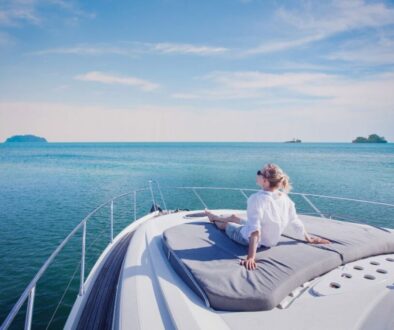
Yachting Benefits You Might Not Know
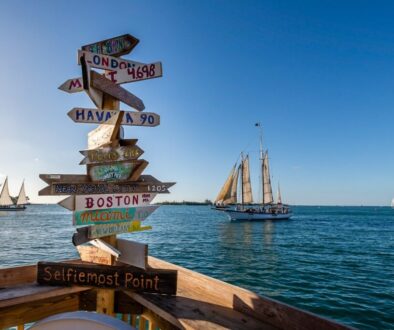
Most Popular , Yachting
How To Charter A Boat From Miami To Key West
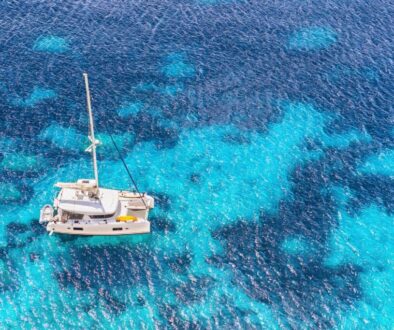
What To Know Before Renting A Catamaran Charter
Find us on social media.

© SeafariYachtCharters.com 2024
View Our Privacy Policy
Website design by Correct Digital

Top Ten Tips for Ocean Passage Making

It took an enormous planning effort. Not only did we have to plan the usual things like navigation, provisions, fuel, etc., but also, we were actively working while crossing, so we needed to have good communication. We used a software called OCENS with our Iridium Satellite phone to send and receive email and for making calls, as well as getting the weather forecast. That was back in 2005. Today it is much easier and cheaper to do. As we all know, good seamanship requires numerous preparations especially for successful ocean passage making. Stephen and I each have our own dedicated areas of responsibility to prepare the boat and the crew. That way we know what is expected of each crew member and there is no confusion about who did what. We then double check to make sure all items have been taken care of before we cast off. Our key planning activities are outlined below.
1. Plan Your Passage

2. Wait For A Weather Window
The basic rule we use to avoid trouble is to wait for a weather window for the upcoming passage. Usually we wait for light conditions to ease into a trip (Estelle usually feels a little queasy the first day out), other times we leave on the tail of a weather system that will help us along for a day or so. The general rule is that most forecasts today are fairly accurate for 3-5 days. Beyond that it is unpredictable and one should plan for unexpected conditions. We have learned over the years that setting a specific date for departure or having a schedule getting to places is complete folly. Leaving in adverse conditions to meet a deadline is asking for trouble.
3. Offshore Sailing Preparation Checklist

4. Check And Test Emergency Gear
Renew EPIRB with updated information with NOAA. Check that MOB strobe light batteries are good and flares are in date. Make sure that the MOB horseshoe ring and lifesling is attached properly, life jackets and harnesses are easily accessible and that all crewmembers know where they are stowed. Make sure that your life raft is in date and easily accessible and that every crewmember knows how to operate it. Check your ditchbag and medical kit and replenish or replace supplies. Again, make sure it is easily accessible and that the crew knows where it is stowed. Make sure that your crew knows how to do a crash stop and what to do to retrieve a man over board.
5. Navigation Gear
Test the VHF and have at least one hand held VHF for emergencies. Check that the autopilot functions well and if possible, carry a spare. Radar is good to have, specially if you plan to sail in areas with heavy fog or busy shipping channels and it is invaluable for tracking squalls. Make sure your GPS functions correctly and have a spare handheld just in case. ALWAYS have paper charts in case all electronics fail and log the trip in your ship’s log. We used our iPads for navigation and plotted ourselves every 6 hours on the paper chart. We particularly liked the BoatBeacon App on the iPad that functions as an AIS Marine navigation system, tracking shipping traffic on the Cheaspeake Bay.
6. Boat Provisioning
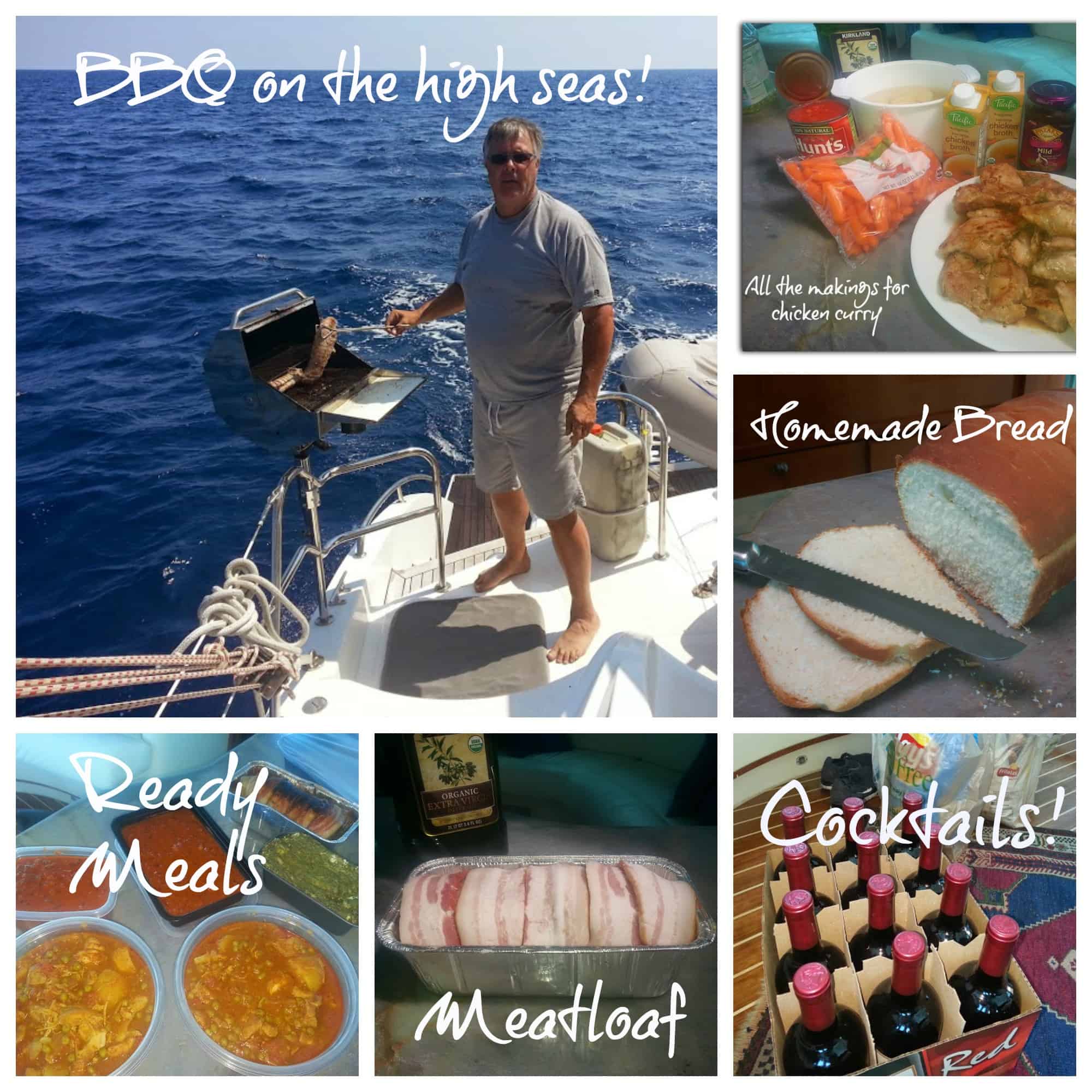
Make sure that the crew is properly fed. It is good for morale and makes for a happy environment on board. Make up an informal menu for the approximate number of days on passage and add 20% plus some emergency food items like canned tuna, chicken, corned beef, and beans or whatever you prefer, we like protein. In dire situations, if all goes wrong on board, one can easily eat these items cold and from the can if need be. Also stock up on some protein bars. Make an inventory of food aleady on board and add ingredients on the menu to shop for.
I usually purchase the dry goods on the menu first and stow. The day before we leave, I get the perishable items. This makes for a less overwhelming task. Organize galley lockers or pantry with food items to be used on the passage in easily reachable places to minimize looking for ingredients all over the boat. I usually buy tomatoes, avocado, pineapple, mangoes and bananas as green as possible to ripen over time. Potatoes and onions get stowed in a dark dry place. Oranges, lemons, apples, cabbage, carrots, squash etc. last a long time and mostly does not need refrigeration, so I get a fair amount of it instead of things like lettuce.
We like eggs for breakfast so I buy fresh eggs for a few days and eggbeaters to make scrambled egg or omelets. I usually plan simple, easy to prepare meals for our passages, especially for the first few days out. I pre-prepare at least three simple but satisfying meals ( chicken curry , meatloaf, shepards pie, pasta Bolognese, etc.) and freeze it for bad weather days. I always have a few steaks in the freezer for a nice day when we can BBQ off the back of the boat and of course when we catch fish, we like to make sashimi or grill the fish straight away. If conditions are good, I will bake bread every 3-4 days. We tend to snack during night watches, so I bake cookies before we leave and have some candy bars stowed away. Check out the Boatgalley.com provisioning tips .
Feel free to contact me for comprehensive provisioning planning.
7. Fishing Gear

8. Watch Keeping
Our watch keeping system is simple. We ALWAYS have someone on watch but since we rely on the autopilot to steer the boat, we only have to watch for ships, obstructions, make log entries and check our sails occasionally. We do not rotate our watches because our bodies adjust better to watches if we do the same ones every night.
When it is only the two of us, we do three hours on and three hours off but we make it shorter with more crew so that we get some decent rest in between watches. During the day it’s sort of a loose system with one or the other or both on watch while we tend to our chores like cooking, navigation etc. Stephen usually makes the rounds on deck inspecting for chafe and other areas of concern during the day. In particularly bad weather, we will do 1-hour watches if the autopilot labors too hard and we are required to hand steer. Stephen’s method of using an egg timer seems to work really well for night time watches.
He sets the timer for 14 minutes at which time he gets up, checks for lights and generally makes sure that everything is as it should be for about 3 minutes and goes back to reading or taking a nap. It helps break up the time and after a night or two, your body gets used to the routine.
9. Water Management On Board

10. Marine Fuel And Batteries
We had our tanks cleaned out and fuel polished this season after we detected some nasty critters and water in the fuel filters. This can become a real issue so make sure that your fuel is as clean as possible. Fill fuel tanks and manage this resource. Figure out what distance you can motor (we do under a gallon per hour per engine and we run only one engine at a time) and make sure that you conserve enough fuel to motor into a harbor or motor yourself out of a sticky situation. Running the tanks dry will lead to having to bleed the fuel system, not a difficult thing to do but very unpleasant at sea. We usually have emergency fuel in jerry cans in case we motor more than expected and we run out. Make sure that you carry spare impellers, fan belts and fuel filters and know how to change them, usually a fairly simple procedure. It is advisable that you do an engine course to understand the basics about your engine. Manage your charging system diligently. We use approximately 15- 20 amps per hour with the autopilot, fridge / freezer, lights and other stuff. We usually keep our batteries maintained by charging 2 hours per day (by generator as it uses less fuel) and have solar panels that will give us a further 60-80 amps per day, unless overcast. That seems to keep us going pretty well but we are always very careful not to waste this resource.
Here’s more info on power management on modern cruising catamarans .
Check out our photo slideshow .
Read the Trip Report from the crew onboard catamaran Zuri on our offshore ocean passage.
Contact us for more in depth information or leave a comment with your tips on ocean passage making.
Estelle Cockcroft
Join our community.
Get the latest on catamaran news, sailing events, buying and selling tips, community happenings, webinars & seminars, and much more!
Leave a Comment Cancel Reply
Your email address will not be published. Required fields are marked *
Save my name, email, and website in this browser for the next time I comment.
Recent Posts

First-Annual Virgin Islands Boating Exhibition (VIBE)
VIBE – It’s a Destination Boat Show! Join us May 10 – 12 at
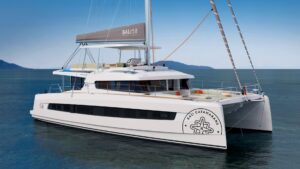
BALI Catamarans Unveils The New Bali 5.8 Flagship
CATANA GROUP launches its 14th BALI CATAMARAN model, the BALI 5.8, for the brand’s
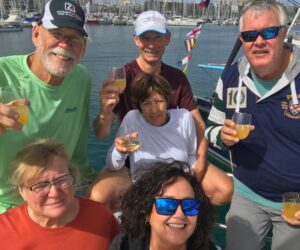
Love Stories At Sea…because it’s valentine’s day
Because it’s Valentine’s day, we wanted to celebrate all the couples that we helped
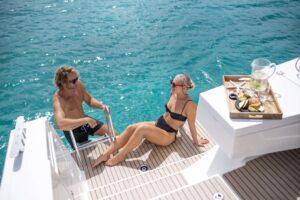
Your Go-To Resource for all your Catamaran Needs!
Check out our brochure to learn about all we have to offer and why

For more than 30 years, we have been a part of the catamaran community and created Catamaran Guru™ to encourage and educate all the aspiring sailing out there. We understand the dream of traveling the world by catamaran and created a one-stop-shop to make that dream a reality for you.

- Stephen & Estelle
- Testimonials
Get Started
- Yacht Sales
- Used Yachts
- Charter Management
- Boat as Business Programs
- Seminars & Events

Can You Sail a Catamaran Around The World?

Last Updated by
Daniel Wade
August 30, 2022
Many people have sailed around the world in traditional monohull sailboats, but has anybody tried with a catamaran?
Sailing around the world is hazardous and trying at times, so it pays to have a sailboat that's built for the job. Sailors place a premium on safety and comfort—so where do catamarans fit into the equation?
Yes, you can sail a catamaran around the world. In fact, full-size catamarans are some of the best circumnavigation sailboats on the market. They offer superior comfort, safety, storage space, and speed when compared to monohulls.
Catamarans have become increasingly popular since the 1990s, and they're seen in ports all over the world. If you consider their handling characteristics, it's no wonder they're so popular for circumnavigation. But what are the things that make cruising catamarans so good for long ocean voyages?
We sourced the information used in this article from sailboat design guides and the online sailing community. We also considered the input of several experienced catamaran captains, most of which have embarked on circumnavigations in catamarans and monohulls.
Table of contents
Can You Circumnavigate in a Catamaran?
You can absolutely sail a catamaran around the world! In fact, catamarans are preferred by many sailors for long ocean voyages, and dozens circumnavigate in all seasons each year. The number of catamarans continues to rise every year, and some of the world’s most influential long-distance sailors have switched to them from monohulls.
There are many benefits to choosing a catamaran for a circumnavigation, and we’ll cover some of those soon. But first, here’s what makes a catamaran suitable for an around the world sailing trip.
What Kind of Catamaran Can Sail Around the World?
Not all catamarans are ideal for long ocean voyages, but the vast majority above 25 feet in length are. The kind of vessel that's suitable for a long ocean voyage is called a cruising catamaran.
Cruising catamarans have a number of defining characteristics that make them ideal for Sailing around the world. Here are a few of them.
Cruising catamarans have extensive cabinet space. Smaller catamarans that aren't designed for large ocean voyages aren't designed for comfort. Cruising catamarans have between two and four staterooms, along with a large covered cockpit and standing headroom throughout.
High Freeboard
Cruising catamarans have a high freeboard, which means the decks are relatively high above the water. They also have a shallow draft, as a catamaran has no need for a centerboard, fin keel, or bulb keel.
Catamarans are not as long as monohulls relative to their capabilities. A 35 or 40-foot catamaran has much more interior space than an equivalently-sized monohull. Catamarans split their living quarters between the two hulls and include an additional spacious covered cockpit above.
Cruising catamarans range in size from 30 feet to 60 feet in length, and they typically measure around 40 to 50 feet from stem to stern. The bottom limit for livable Catamarans seems to be about 25 to 30 feet. Catamarans that are smaller than this lack the space for comfortable living accommodations.
Benefits of Catamaran Circumnavigation
Catamarans are quick and robust, and they make excellent long-term cruising sailboats. They're spacious, safe, comfortable, and have exceptional handling characteristics in almost all weather conditions. Here are some of the main advantages of choosing a catamaran to sail around the world.
Speed is one of the most significant benefits of sailing a catamaran around the world. The ocean is a huge place—and unless you're sailing just to sail, it's always advantageous to shorten the time between destinations.
Catamarans are fast—really fast. A typical cruising catamaran can reach speeds in excess of 20 knots in the best conditions, which is more than twice as fast as a typical monohull. This is because catamaran hulls cancel out the hydrodynamic interference that limits the 'hull speed' of monohulls.
Speed also has other important benefits. For one, it reduces the amount (and cost) of provisions that you need to store aboard. Additionally, speed gives you more flexibility when planning and avoiding weather.
Comfort in Rough Weather
Speaking of weather, catamarans have another notable advantage: stability. Catamarans are inherently stable vessels, and they ride much more softly in the rough weather than traditional sailboats.
Catamarans distribute their weight between two hulls. These hulls are connected on the tops, and water is free to flow in between them. Catamaran hulls are also sharp and narrow, and their shape allows wave punching.
This allows them to cut through waves instead of riding over them, and the effects of lateral rolling are also greatly diminished. That means it won't roll as violently from side to side.
All that extra stability contributes to the overall safety of the catamaran design. Since they incorporate two hulls, catamarans are extremely difficult to capsize.
There's another hidden safety benefit of the catamaran design. If in the very unlikely event that you capsize, a catamaran will float just as well upside down provided the hulls split apart. This makes it an effective life raft in a catastrophic situation.
Extra Storage Space
Catamarans have tons of extra storage space, especially if you're traveling with a smaller crew. A typical cruising catamaran has accommodations for around eight people or more and usually includes at least four bunk areas in the hulls.
With all that extra room, there's plenty of space to store food, toiletries, emergency supplies, souvenirs, and personal items. There's also plenty of room for guests.
Room for More Passengers
Catamarans have many more sleeping spaces than an equally sized conventional sailboat. Catamarans usually include two master staterooms in the forward part of each hull and two aft.
The hulls typically contain at least one head in each, and usually two. Some catamarans include four large bathroom/shower combinations, which give each passenger or couple a private bathing area.
Larger 'Day Living' Spaces
Catamarans also have larger living areas between the hulls. The cockpit of a cruising catamaran is usually covered and spans almost the entire beam of the vessel.
This space often contains the galley and a large sitting area, along with a chart table and other essential equipment. The hulls can be accessed on either side of this space, and there's usually a large window forward.
There's standing headroom throughout the covered cockpit. It more than makes up for the lost space in the comparatively narrow hulls, as these areas are used primarily for sleeping.
Shallow Draft
Catamarans don't need an extended keel for stability. As a result, they draw very little water and can traverse shallow waters that similarly sized monohulls couldn't dream of accessing.
It's easy to beach a catamaran which makes it an excellent island-hopping boat as well. Plus, when the tide runs out, a catamaran will rest evenly on the seabed without any additional supports.
Cons of Sailing Around The World in a Catamaran
So what are the cons of sailing a catamaran around the world? We covered many of the benefits, and we'll touch on a few additional topics here. But there are some downsides that are important to consider.
Size Limitations
Size is your friend out on the open ocean. The wide beam and considerable length of most cruising catamarans make them exceptionally safe and comfortable in a variety of weather conditions. However, most marinas aren't designed for Doublewide boats, and size restrictions could cause headaches in many parts of the world.
The problem of having a wide boat extends beyond the marina. Many channels in passageways can't accommodate wide boats, and those that to me charge more for your passage.
Structural Deficiencies
The vast majority of cruising catamarans are extremely well-built and will never suffer any serious structural failures. However, the basic design of a catamaran makes it vulnerable in certain places, specifically where the hull meets the frames that hold them together.
There have been several cases of catamarans literally snapping in half, usually when under tremendous load or when improperly maintained. This can usually be attributed to a flaw in a specific vessel, and it's not very common. But it is a possibility, and monohulls are not susceptible to it.
Cost to Sail a Catamaran Around the World
Are you waiting for the downsides of sailing a catamaran? Cost is the biggest one. Catamarans are obscenely expensive compared to conventional single-hull sailboats.
The average new catamaran cost upwards of $300,000, and some cost as much as $750,000. An equivalent monohull, new from the factory, costs around $150,000-$200,000. Cruising catamarans don't lose much value either, and you're still likely to pay over $100,000 for one.
Compare that to a monohull. A conventional sailboat that's capable of sailing around the world (say, 40 feet or so in length) is likely to cost between $30,000 and $60,000. Some are even cheaper. For many people, the cost is the prohibiting factor when choosing a sailboat to circumnavigate with.
How Popular are Catamarans for Circumnavigation?
If you've spent much time in the sailing community, you've undoubtedly noticed the prolific number of catamarans on YouTube, internet forums, and sailing blogs. But are catamarans really as popular as they seem, or is it just a case of selection bias?
Catamarans are surprisingly popular these days, but mostly among buyers of new and lead model sailboats. Catamarans, as we know them today, weren't produced in great numbers until recently, and they've only been popular for sailing around the world since the 2000s.
Over the years, an increasing number of people have chosen a catamaran as their long-range cruising sailboat, and the sailing community widely accepted the superior handling and comfort of these vessels.
Catamaran Vs Monohull for Circumnavigation
So, which is better for sailing around the world, a catamaran or a monohull? When it comes to sailing around the world, a Catamaran is an obvious choice for a number of reasons. Speed, safety, and comfort or the primary benefits, and these are worth their weight in gold on a long circumnavigation.
Catamaran Vs Trimaran for Circumnavigation
But what about the trimaran? Many multihull sailors prefer the trimaran due to its superior speed, and many claim it has better motion comfort as well. A trimaran, which has three hulls, is a sizable upgrade from a monohull.
Comparatively, a trimaran is a much less considerable improvement over a catamaran. They also cost more, but the exceptional handling and motion comfort of a trimaran is worth it to many.
Related Articles
How to Sail Around the World
What Size Catamaran To Sail Around The World
I've personally had thousands of questions about sailing and sailboats over the years. As I learn and experience sailing, and the community, I share the answers that work and make sense to me, here on Life of Sailing.
by this author
Most Recent

What Does "Sailing By The Lee" Mean?
October 3, 2023

The Best Sailing Schools And Programs: Reviews & Ratings
September 26, 2023
Important Legal Info
Lifeofsailing.com is a participant in the Amazon Services LLC Associates Program, an affiliate advertising program designed to provide a means for sites to earn advertising fees by advertising and linking to Amazon. This site also participates in other affiliate programs and is compensated for referring traffic and business to these companies.
Similar Posts

How To Choose The Right Sailing Instructor
August 16, 2023

Cost To Sail Around The World
May 16, 2023

Why Do Catamarans Have Trampolines?
April 17, 2023
Popular Posts

Best Liveaboard Catamaran Sailboats
December 28, 2023

Can a Novice Sail Around the World?
Elizabeth O'Malley
June 15, 2022

4 Best Electric Outboard Motors

How Long Did It Take The Vikings To Sail To England?

10 Best Sailboat Brands (And Why)
December 20, 2023

7 Best Places To Liveaboard A Sailboat
Get the best sailing content.
Top Rated Posts
Lifeofsailing.com is a participant in the Amazon Services LLC Associates Program, an affiliate advertising program designed to provide a means for sites to earn advertising fees by advertising and linking to Amazon. This site also participates in other affiliate programs and is compensated for referring traffic and business to these companies. (866) 342-SAIL
© 2024 Life of Sailing Email: [email protected] Address: 11816 Inwood Rd #3024 Dallas, TX 75244 Disclaimer Privacy Policy

Learn the Basics of Small Catamaran Sailing: A Step-by-Step Guide
Alex Morgan
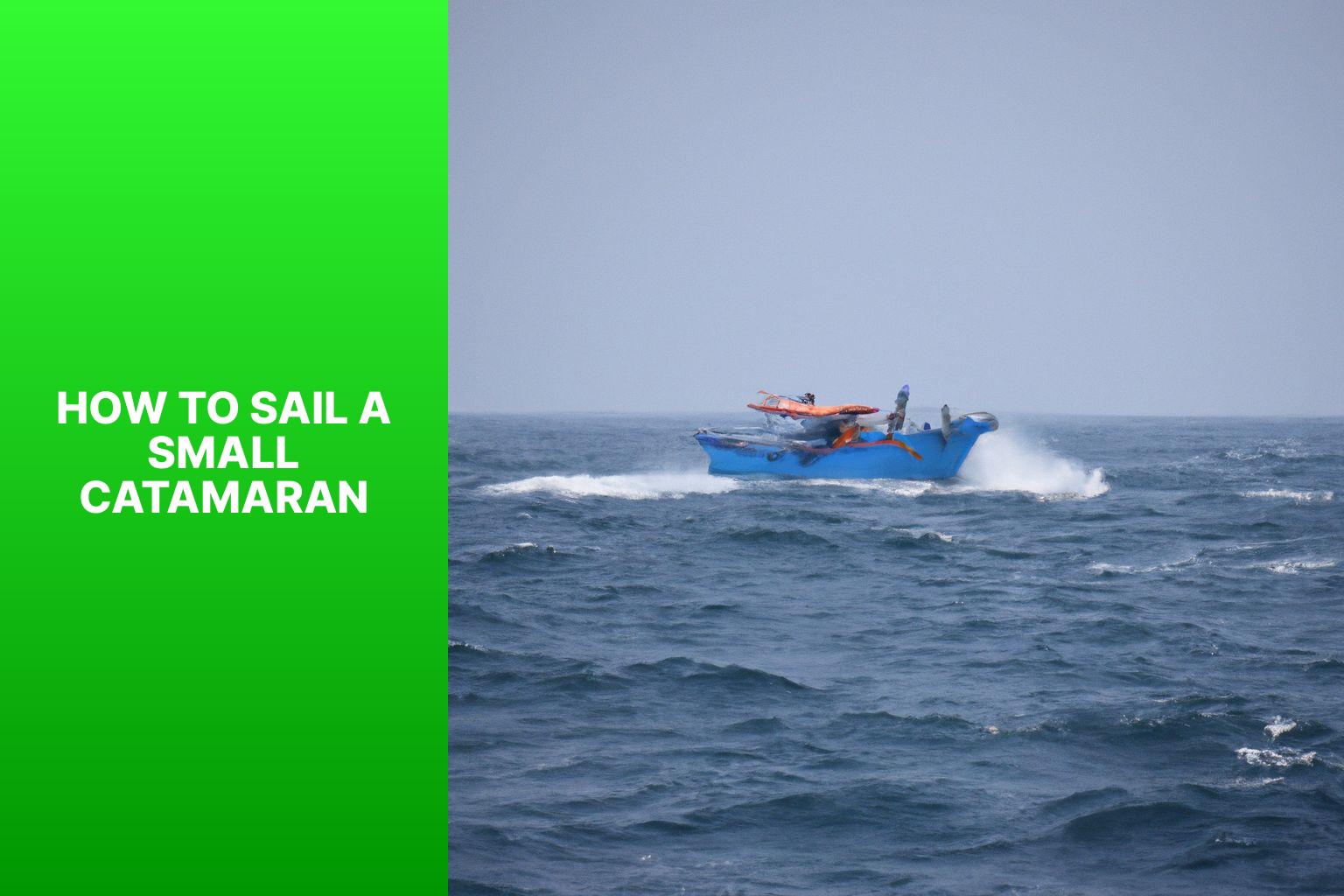
Sailing a small catamaran can be an exhilarating experience, allowing you to harness the power of the wind and glide across the water. Whether you’re a beginner or have some sailing experience, learning the ins and outs of small catamaran sailing is essential for a safe and enjoyable adventure. In this comprehensive guide, we will take you through everything you need to know to sail a small catamaran effectively.
Introduction to Small Catamarans
Small catamarans are multi-hull sailboats that consist of two parallel hulls connected by a frame. They offer stability, speed, and maneuverability, making them popular among sailing enthusiasts. Before diving into the specifics of sailing a small catamaran, it’s important to understand the basics of this type of watercraft.
Getting Started with Small Catamaran Sailing
To begin your small catamaran sailing journey, there are a few key considerations to keep in mind. Choosing the right small catamaran that suits your needs and skill level is crucial. Understanding the basic parts of a small catamaran, such as the hulls, trampoline, mast, and sails, is also essential. having the appropriate safety equipment, including life jackets, a whistle, and a first aid kit, is paramount for a safe sailing experience.
Learning the Fundamentals of Small Catamaran Sailing
Learning the fundamentals of small catamaran sailing will lay the foundation for a successful and enjoyable sailing experience. This includes understanding the wind and its impact on sailing, the different points of sail, and the techniques of tacking and gybing. Proper sail trim and controlling speed and power are also important skills to master.
Basic Maneuvers in Small Catamaran Sailing
Once you have grasped the fundamentals, it’s time to learn some basic maneuvers in small catamaran sailing. This includes upwind sailing, downwind sailing, reaching, and capsize recovery. Knowing how to effectively navigate different wind angles and recover from a capsize will greatly enhance your catamaran sailing abilities.
Advanced Techniques for Small Catamaran Sailing
For those looking to take their small catamaran sailing skills to the next level, there are advanced techniques to explore. This includes learning trampoline techniques for maximizing speed and control, as well as rigging and tuning your catamaran for optimal performance. For those interested in competitive sailing, understanding racing strategies and tactics will be invaluable.
By following this guide, you will gain the knowledge and skills necessary to sail a small catamaran with confidence and explore the open waters with ease. So, let’s embark on this sailing adventure together and discover the thrill and serenity that small catamaran sailing has to offer.
– Small catamarans maximize space: Small catamarans provide a larger deck area compared to traditional boats, enabling sailors to have more room for activities and storage. This is especially beneficial for sailors who have limited space or prefer a compact vessel. – Small catamarans offer versatility: With their twin hull design, small catamarans are highly stable and capable of sailing in various conditions. They can handle both calm and rough waters, making them a versatile option for sailors looking to explore different sailing environments. – Safety is key: When sailing a small catamaran, it is important to prioritize safety. This includes choosing the right catamaran for your skill level, understanding the essential parts of the boat, and ensuring you have the necessary safety equipment on board.
Embarking on the thrilling adventure of small catamaran sailing? This section is your compass to getting started! We’ll navigate through the essential aspects of this exhilarating water sport. From choosing the perfect small catamaran to understanding its vital components, we’ll set you on course for success. Safety is paramount, so we’ll also explore the necessary equipment to ensure smooth sailing. Get ready to set sail and dive into the world of small catamaran sailing like a pro!
Choosing the Right Small Catamaran
To choose the right small catamaran, consider key factors. Here is a table summarizing important aspects to take into account:
Choosing the right small catamaran is crucial for an enjoyable and safe sailing experience. Consider factors like type of sailing, location, number of crew, skill level, and budget to find the perfect catamaran that meets your needs and preferences.
Fact: The fastest recorded speed on a small catamaran was 51.36 knots (about 59 mph), achieved by Paul Larsen of Australia in 2012.
Understanding the Basic Parts of a Small Catamaran
To gain a comprehensive understanding of the basic parts of a small catamaran, it is important to familiarize yourself with the key components that make up this type of watercraft. These components include the following:
1. Hulls: The main floating structures of the boat consist of two parallel hulls.
2. Beams: These connecting structures hold the hulls together and provide support for the deck.
3. Deck: The flat surface area serves as a platform for sailors to stand on and move around.
4. Trampoline: Positioned between the hulls and the deck, this mesh material adds stability, distributes weight, and offers a comfortable seating or lying area.
5. Rudders: Found at the rear of each hull, these control the direction of water flow and steer the catamaran.
6. Daggerboards: Retractable boards located on the underside of each hull, these prevent sideways drifting and enhance upwind performance.
7. Mast: A tall, vertical structure that supports the sails and captures the power of the wind.
8. Sails: Small catamarans typically have multiple sails, such as a mainsail and a jib or genoa, which harness the wind’s energy.
9. Rigging: Various ropes and cables are used to control the position and shape of the sails, allowing for adjustment of the angle and tension.
10. Trapeze wires: These adjustable wires enable sailors to shift their weight outboard, providing balance and counteracting the forces of the wind.
Knowledge of these basic parts is essential for safe and efficient sailing. Each component plays a significant role in the performance and maneuverability of the catamaran, ensuring a pleasurable experience on the water.
Essential Safety Equipment
The essential safety equipment for small catamaran sailing includes:
Life jackets: Each person on board should have a properly fitted life jacket approved by relevant authorities. Ensure accessibility and good condition.
Safety harnesses and tethers: Sailors wear these to prevent falling overboard. Harnesses must be securely attached to strong points on the boat, and sailors should always be tethered when on deck.
Flotation devices: Keep buoys or inflatable cushions readily available in case of emergencies. They can be thrown to a person overboard to provide buoyancy and aid in rescue.
Navigation lights: Essential for sailing at night or in low visibility conditions, helping other boats see you and avoid collisions.
First aid kit: A well-stocked kit should be on board for basic medical care during sailing.
Fire extinguisher: Crucial in case of fires or emergencies. Regularly check and maintain the extinguisher.
True story:
One sunny day, while sailing on a small catamaran, our crew encountered unexpected strong winds and choppy waters. Suddenly, a crew member lost their balance and fell overboard. Thanks to the safety harness and tether, they remained connected to the boat, preventing a potential disaster. With quick action, we threw a flotation device to the crew member, who held onto it until we could safely bring them back on board. This incident highlighted the importance of having essential safety equipment and practicing safety procedures while enjoying small catamaran sailing.
Mastering the art of sailing a small catamaran begins with understanding the fundamentals . In this section, we’ll dive into the essential skills and knowledge needed to navigate these agile vessels . Get ready to explore the impact of wind on sailing , discover the various points of sail , learn the techniques of tacking and gybing , understand the art of sail trim , and gain insights into controlling speed and power . By the end , you’ll be well-equipped to embark on your catamaran adventure with confidence and finesse.
Understanding Wind and Its Impact on Sailing
Understanding Wind and Its Impact on Sailing is crucial for small catamaran sailors. Consider the following key points:
– Wind powers sailing by propelling the boat forward and determining the direction of travel.
– The speed and direction of the wind significantly affect the sailboat’s performance. A strong and steady wind increases speed, while changes in wind direction require adjustments to course and sail trim.
– Sailors must understand different points of sail. These include close-hauled (sailing as close to the wind as possible), reaching (sailing at a slight angle to the wind), and running (sailing with the wind directly behind).
– Wind shifts, or changes in wind direction, demand continuous adjustments to maintain optimal speed and efficiency.
– Be aware of gusts , sudden increases in wind speed. Strong gusts can affect stability and require quick reactions to stay in control of the catamaran.
– Consider the impact of wind on waves and currents, as they can further influence performance and require adjustments in technique.
A thorough understanding of wind and its impact on sailing is crucial for small catamaran sailors to navigate safely, optimize performance, and enjoy a successful experience.
Points of Sail
The sub-topic “ Points of Sail ” can be presented in a table to provide a clear understanding of each point of sail and the corresponding wind direction.
Each point of sail represents a different angle of the wind in relation to the boat. Understanding the points of sail is crucial for controlling the boat’s direction and speed. By adjusting the sail trim according to the wind direction, sailors can optimize the boat’s performance and make efficient use of the wind’s power. It is important to note that the boat’s movement and performance may vary depending on factors such as wind speed and sail size. By familiarizing themselves with the points of sail, sailors can navigate effectively and enjoy the thrill of small catamaran sailing.
Tacking and Gybing
To tack , steer the boat towards the wind to change direction. Release the mainsail sheet and jib sheet to allow the sails to luff. Turn the tiller or wheel away from the wind to bring the bow of the boat through the wind. Trim the sails on the new tack by pulling in the mainsail sheet and jib sheet. Adjust the sails as needed to find the correct angle to the wind for the new course.
To gybe , steer the boat away from the wind to change direction. Release the mainsail sheet and jib sheet to allow the sails to luff. Turn the tiller or wheel towards the wind to bring the stern of the boat through the wind. Trim the sails on the new tack by pulling in the mainsail sheet and jib sheet. Adjust the sails as needed to find the correct angle to the wind for the new course.
Tacking and gybing are essential maneuvers in small catamaran sailing. Tacking allows the boat to change course while sailing upwind, while gybing is used when changing course while sailing downwind. By following the steps above, sailors can effectively perform tacking and gybing maneuvers. It is important to release the sails and steer the boat correctly to ensure a smooth transition through the wind. Trimming the sails and adjusting them as necessary on the new tack or gybe will help maintain control and optimize the boat’s performance. Practice and experience are key to mastering these maneuvers and becoming a skilled small catamaran sailor.
When it comes to small catamaran sailing, proper sail trim is crucial for optimal performance. Here are some key considerations for achieving the correct sail trim:
– Adjust the main sail: Trim the main sail by tightening or loosening the main sheet. A well-trimmed main sail will have a smooth shape and minimal wrinkles.
– Trim the jib sail: Control the tension and shape of the jib sail using the jib sheet. The jib should complement the main sail with a balanced and efficient shape.
– Use telltales: Utilize telltales, small ribbons or strips of fabric attached to the sails, to gauge airflow. Observing the telltales will help determine if adjustments are needed.
– Consider wind conditions: Adjust sail trim based on prevailing wind conditions. In lighter winds, looser sails are needed to catch lighter breezes. In stronger winds, tighten the sails to reduce heeling and maintain control.
– Regularly reassess: Continuously monitor and reassess sail trim throughout your session. Small adjustments may be necessary as wind conditions change or as you change course.
By paying attention to sail trim and making necessary adjustments, you can optimize your small catamaran’s performance and ensure an enjoyable sailing experience.
Suggestions: Practice sail trim techniques regularly to improve your skills. Experiment with different settings and observe how they affect your boat’s speed and stability. Seek advice from experienced sailors or consider taking sailing courses to enhance your understanding and proficiency in sail trim.
Controlling Speed and Power
Controlling speed and power in small catamaran sailing is crucial and involves several important steps. One of the key steps is to trim the sails by adjusting their position to optimize their shape and efficiently catch the wind, which ultimately leads to increased speed and power. Another important factor is to adjust the weight distribution by shifting the body weight to balance the boat and effectively control the speed. Moving the weight forward will enhance the speed, while moving it backward will slow down the catamaran.
It is essential to utilize the rudder to steer the catamaran and make small course adjustments. By using the rudder effectively, one can maintain speed and control. Another aspect to consider is harnessing the wind . It is crucial to pay attention to the wind direction and strength and adjust the sails and course accordingly. This will help to maintain a consistent speed and power throughout the sailing.
Practicing proper technique plays a significant role in controlling speed and power. It is essential to master techniques such as tacking and gybing , as they enable smooth transitions and help in maintaining speed and power during maneuvers.
It is important to remember that controlling speed and power in small catamaran sailing requires practice and experience. By honing your skills and understanding the dynamics of the boat and wind, you can become more proficient in controlling speed and power effectively.
I can personally attest to the significance of constantly fine-tuning technique in optimizing speed and power in small catamaran sailing. In a sailing race, I found myself trailing behind other boats. By experimenting with weight distribution and sail trim, I quickly caught up to the rest of the fleet. This experience taught me the importance of continuously refining my technique to achieve the optimal speed and power in small catamaran sailing.
Basic Manuevers in Small Catamaran Sailing
Mastering the art of sailing a small catamaran starts with understanding the basic maneuvers. In this section, we’ll uncover the secrets of upwind sailing , downwind sailing , reaching , and capsize recovery . Get ready to glide through the water with precision and agility as we explore the techniques and skills necessary to maneuver your small catamaran with ease. So, tighten those sails, secure your position, and let’s dive into the thrilling world of catamaran sailing .
Upwind Sailing
Position yourself in the boat for upwind sailing: Sit on the trampoline with your feet facing forward, one foot in front of the other, for balance and stability.
Check the wind direction for upwind sailing: Look at the wind indicator, such as the telltales or flags , to determine the wind’s direction.
Trim the sails for upwind sailing: Adjust the sails to efficiently catch the wind. Increase the curvature of the sails for better lift.
Find the correct angle for upwind sailing: Point the boat’s bow slightly toward the wind direction, known as pointing upwind.
Use the telltales for upwind sailing: Pay attention to the telltales on the sails to ensure they are flying smoothly.
Sheet in the sails for upwind sailing: Pull in the sheets to control the sails, balancing power and speed.
Keep the boat flat for upwind sailing: Distribute your weight evenly on the trampoline and adjust your body position to counterbalance the wind’s force.
Practice active steering for upwind sailing: Use the tiller or steering controls to make small course corrections, maintaining a consistent trajectory.
Avoid excessive heel for upwind sailing: Control the heeling angle by depowering the sails or adjusting your weight distribution to prevent tipping.
Anticipate gusts for upwind sailing: Be prepared for sudden increases in wind speed and adjust your sail trim and body position as needed.
Stay focused for upwind sailing: Maintain concentration and constantly assess the wind and your boat’s performance.
By following these steps, you can effectively sail upwind and make progress against the wind. Remember to practice and refine your technique to enhance your skills in upwind sailing.
Downwind Sailing
Downwind sailing is an exciting technique in small catamaran sailing. Follow these steps to successfully navigate downwind:
- Position your catamaran with the wind behind you.
- Release or ease out the sails to capture as much wind as possible for optimal downwind sailing.
- Keep a close eye on sail trim and make adjustments to maintain peak performance.
- Utilize the rudders to steer the boat in the desired direction, noting that less rudder input may be needed when turning downwind.
- Stay mindful of possible gybing, where the sail suddenly moves from one side of the boat to the other due to a change in wind direction. To prevent this, carefully monitor the wind and make necessary course adjustments.
- Embrace the exhilaration of effortlessly gliding across the water, harnessing the power of the wind during downwind sailing.
Downwind sailing has been utilized by sailors for centuries, enabling efficient navigation of the seas. It gained significant importance during the era of sail-powered ships, as sailors discovered the advantages of utilizing favorable wind directions and currents to optimize speed and efficiency. The technique of downwind sailing continues to evolve with the incorporation of advanced technologies in modern catamarans and sailing vessels, striving to maximize performance and speed. Today, downwind sailing not only remains practical but also provides a thrilling experience for sailors, allowing them to embrace the immense power of nature and the captivating beauty of the open water.
Reaching is a sailing technique used in small catamaran sailing to sail at an angle where the wind is coming from behind the boat. It allows the boat to sail faster and more efficiently.
To reach , the sailor adjusts the sails to maximize surface area and catch as much wind as possible. This propels the catamaran forward.
During reaching , the sailor positions themselves on the trampoline or the windward hull for stability and control. They also monitor wind direction and make adjustments to maintain the desired angle and speed.
Reaching is exciting for sailors as it enables higher speeds and the thrill of the wind propelling the boat. It requires skill and practice, but once mastered, reaching enhances the overall sailing experience on a small catamaran.
Capsize Recovery
Capsize Recovery is vital for small catamaran sailing. Here is a guide to effectively recover from a capsize:
- Stay calm and assess the situation.
- Hold onto the boat and ensure everyone is accounted for.
- Signal for help if necessary, especially in a busy waterway.
- Try to right the boat by pushing down on the centerboard or daggerboard.
- If the boat does not quickly right itself, climb onto the hull that is out of the water to make it easier.
- Once the boat is upright, climb back onboard and assess any damage.
- Bail out any remaining water using buckets or bailers.
- Check all rigging and equipment for damage.
- Restart the engine or raise the sails to continue sailing.
Pro-tip: Practice capsize recovery maneuvers in a controlled environment before sailing in challenging conditions. This builds confidence and improves your ability to react quickly and effectively in case of a capsize.
Mastering the art of small catamaran sailing goes beyond the basics. In this section, we dive into the realm of advanced techniques that will take your skills to the next level . Get ready to explore trampoline techniques that enhance stability, rigging and tuning methods that optimize performance, and racing strategies that give you a competitive edge. Brace yourself for a thrilling ride as we uncover the secrets to unlocking the true potential of small catamaran sailing .
Trampoline Techniques
- Using the trampoline: The trampoline on a small catamaran is crucial for various techniques.
- Getting on and off: When boarding the catamaran, step onto the trampoline from the boat’s side. To disembark, step off the trampoline onto a stable surface.
- Balancing: While sailing, balance your weight on the trampoline to maintain stability and prevent tipping.
- Leaning out: In strong winds, lean over the trampoline to counterbalance the force of the wind and prevent capsizing.
- Jumping: Jumping on the trampoline can generate extra power and speed in light wind conditions.
- Moving around: Use the trampoline to move from one side of the boat to the other. Step carefully and hold onto the boat for stability.
- Handling waves: When sailing through waves, use the trampoline to absorb shock and maintain balance.
- Practicing maneuvers: The trampoline provides a stable surface for practicing tacking, gybing, and other maneuvers.
- Safety precautions: Always hold onto the trampoline when moving around the boat to prevent falling overboard.
Rigging and Tuning
Rigging and tuning are crucial for small catamaran sailing. Here are some essential aspects to consider:
– Rigging: It’s vital to set up and secure the mast, boom, and other rigging components correctly. Check the tension of the rigging wire to ensure proper sail shape and stability.
– Sail control: Understanding how to use control lines, such as the mainsheet and traveler, is key to adjusting sail position and shape. These controls optimize performance and balance the catamaran.
– Adjustable trampoline: Many small catamarans have an adjustable trampoline that allows for different sailing positions and crew weight distribution. This feature affects stability and handling.
– Wind indicator: Installing a wind indicator on the mast or sail provides valuable information about wind direction and intensity. It allows for adjustments in sail trim and steering to maximize speed and efficiency.
– Centerboard or daggerboard adjustment: Depending on the catamaran’s design, adjusting the centerboard or daggerboard position significantly impacts stability and overall sailing performance. Knowing when and how to adjust them is crucial.
– Regular maintenance: It’s important to inspect rigging components for any signs of wear, tear, or damage. Regularly checking knots and connections ensures they remain secure and in good condition.
– Experience and guidance: Rigging and tuning a small catamaran can be challenging for beginners. Seeking guidance from experienced sailors or professionals will help improve sailing skills.
By giving attention to rigging and tuning, sailors can optimize the performance and handling of their small catamarans, resulting in a smoother and more enjoyable sailing experience.
Racing Strategies
- To maximize performance on the water, it is important to start with a good racing strategy. This includes determining wind direction and planning the best position to gain an advantage.
- One crucial aspect of racing strategies is mastering boat handling. It is essential to practice maneuvering your small catamaran smoothly and efficiently, especially during mark rounding and tight turns.
- Another key racing strategy is learning to read wind shifts. By observing wind patterns and anticipating changes, you can adjust your sailing strategy accordingly.
- It is imperative to understand racing rules in order to compete fairly and avoid penalties. Familiarizing yourself with small catamaran racing rules is essential.
- Staying aware of the competition is a vital part of racing strategies. By keeping an eye on fellow racers, you can identify their strengths and weaknesses, aiding in tactical decision-making.
- Developing a strong downwind strategy is crucial. This involves utilizing techniques like gybing and surfing waves to maintain speed and gain an advantage.
- Being adaptable is key in racing. Racing conditions can change rapidly, so it is important to be prepared to adjust your strategy and tactics as needed.
Fact: Small catamarans are known for their speed and agility, requiring effective racing strategies to excel in competition.
Some Facts About How To Sail A Small Catamaran:
- ✅ Learning how to sail a small catamaran can be an exciting and freeing experience. (Source: catamaranfreedom.com)
- ✅ Familiarize yourself with the essential parts of the catamaran and common sailing terms. (Source: catamaranfreedom.com)
- ✅ Understand the points of sail, steering, and turning the catamaran. (Source: catamaranfreedom.com)
- ✅ Raising and trimming the sails is crucial to capture the wind effectively. (Source: catamaranfreedom.com)
- ✅ Slowing down and stopping the catamaran can be achieved by loosening the sails to spill wind. (Source: catamaranfreedom.com)
Frequently Asked Questions
1. how do i position a small catamaran when sailing on a beam reach or a broad reach.
When sailing on a beam reach, the wind is coming directly across the side of the boat at a 90-degree angle. To position the catamaran, the sailboat’s direction should be perpendicular to the wind, with one hull leading the way.
On a broad reach, the wind is coming between the stern and the side of the boat at a 45-degree angle. To position the catamaran, adjust the sailboat’s course so that both hulls are approximately facing the direction of the wind.
2. What are the essential parts of a small catamaran?
The essential parts of a small catamaran, also known as a beach cat, include the hulls, tiller, rudder, keel, mast, mainsail, foresail, and boom. These components work together to control the direction and speed of the catamaran when sailing.
3. How should I handle the tiller when sailing a small catamaran?
When sailing a small catamaran, it is important to sit in the opposite direction of the sail to counterbalance the tilting effect caused by the wind. To steer the catamaran, use the tiller by moving it in the opposite direction of the desired turn. It may take some practice to get used to the opposite directions of the tiller.
4. What sailing gear do I need when sailing a small catamaran?
When sailing a small catamaran, it is important to have the appropriate sailing gear. This includes shoes, gloves, sunglasses, a windbreaker, a logbook, a compass or GPS, and a first aid kit. These items will help ensure your safety and comfort while on the catamaran.
5. How do I turn the catamaran into the wind when sailing close-hauled?
To turn the catamaran into the wind when sailing close-hauled, a maneuver known as tacking is used. Move the tiller toward the sail to pass the bows through the wind. Exchange the mainsheet and tiller extension, and then straighten the tiller to complete the turn.
6. How do I slow down and stop the catamaran when sailing?
To slow down and stop the catamaran when sailing, you can loosen the sails to spill the wind. Let out and loosen the sails until they luff or flap. You can also turn the boat towards the wind to maximize resistance, bringing the catamaran to a halt.
About the author
Leave a Reply Cancel reply
Your email address will not be published. Required fields are marked *
Save my name, email, and website in this browser for the next time I comment.
Latest posts

The history of sailing – from ancient times to modern adventures
History of Sailing Sailing is a time-honored tradition that has evolved over millennia, from its humble beginnings as a means of transportation to a beloved modern-day recreational activity. The history of sailing is a fascinating journey that spans cultures and centuries, rich in innovation and adventure. In this article, we’ll explore the remarkable evolution of…

Sailing Solo: Adventures and Challenges of Single-Handed Sailing
Solo Sailing Sailing has always been a pursuit of freedom, adventure, and self-discovery. While sailing with a crew is a fantastic experience, there’s a unique allure to sailing solo – just you, the wind, and the open sea. Single-handed sailing, as it’s often called, is a journey of self-reliance, resilience, and the ultimate test of…

Sustainable Sailing: Eco-Friendly Practices on the boat
Eco Friendly Sailing Sailing is an exhilarating and timeless way to explore the beauty of the open water, but it’s important to remember that our oceans and environment need our protection. Sustainable sailing, which involves eco-friendly practices and mindful decision-making, allows sailors to enjoy their adventures while minimizing their impact on the environment. In this…

The Ultimate Guide to Choosing Between a Sailboat or Catamaran for Your Sailing Adventures
C hoosing between a sailboat and a catamaran for your sailing adventures is a significant decision that depends on various factors, including your sailing preferences, experience level, budget, and intended use. Here's an ultimate guide to help you make an informed decision:
1. Sailing Experience:
- Sailboats: Typically require more skill and experience to handle, especially in adverse weather conditions. Ideal for sailors who enjoy the traditional feel of sailing and are willing to invest time in learning and mastering the art.
- Catamarans: Easier to handle, making them suitable for beginners. The dual-hull design provides stability, reducing the learning curve for those new to sailing.
2. Space and Comfort:
- Sailboats: Generally have a narrower beam and less living space. However, some sailboats may offer comfortable cabins and amenities.
- Catamarans: Wider beam creates more living space. Catamarans often have multiple cabins, spacious saloons, and expansive deck areas, providing a more comfortable living experience.
3. Stability:
- Sailboats: Monohulls can heel (lean) while sailing, which some sailors enjoy for the thrill but can be discomforting for others.
- Catamarans: Greater stability due to the dual hulls, providing a more level sailing experience. Reduced heeling makes catamarans suitable for those prone to seasickness.
4. Performance:
- Sailboats: Known for their upwind performance and ability to sail close to the wind. Some sailors appreciate the challenge of optimizing sail trim for efficiency.
- Catamarans: Faster on a reach and downwind due to their wide beam. However, they may not point as high into the wind as monohulls.
- Sailboats: Typically have a deeper draft, limiting access to shallow anchorages and requiring deeper marina berths.
- Catamarans: Shallow draft allows access to shallower waters and secluded anchorages, providing more flexibility in cruising destinations.
- Sailboats: Generally more affordable upfront, with a wide range of options available to fit different budgets.
- Catamarans: Often more expensive upfront due to their size and design. However, maintenance costs may be comparable or even lower in some cases.
7. Mooring and Docking:
- Sailboats: Easier to find slips and moorings in marinas designed for monohulls.
- Catamarans: Require wider slips and may have limited availability in certain marinas, especially in crowded anchorages.
8. Intended Use:
- Sailboats: Ideal for traditional sailors who enjoy the art of sailing, racing enthusiasts, or those on a tighter budget.
- Catamarans: Suited for those prioritizing comfort, stability, and spacious living areas, especially for long-term cruising and chartering.
9. Resale Value:
- Sailboats: Generally have a more established resale market, with a wider range of buyers.
- Catamarans: Growing in popularity, and well-maintained catamarans often retain their value.
10. Personal Preference:
- Consider your personal preferences, the type of sailing you plan to do, and the kind of lifestyle you want aboard your vessel.
In conclusion, both sailboats and catamarans have their advantages and disadvantages. Your decision should be based on your individual preferences, experience level, budget, and intended use. If possible, charter both types of vessels to experience firsthand how they handle and to help make a more informed decision based on your own preferences and needs.
The post The Ultimate Guide to Choosing Between a Sailboat or Catamaran for Your Sailing Adventures appeared first on Things That Make People Go Aww .

A cargo ship’s ‘WindWing’ sails saved it up to 12 tons of fuel per day
After six months sailing around the world, the numbers are in for the retrofitted ‘Pyxis Ocean.’
By Andrew Paul | Published Mar 14, 2024 10:00 AM EDT
- Environment
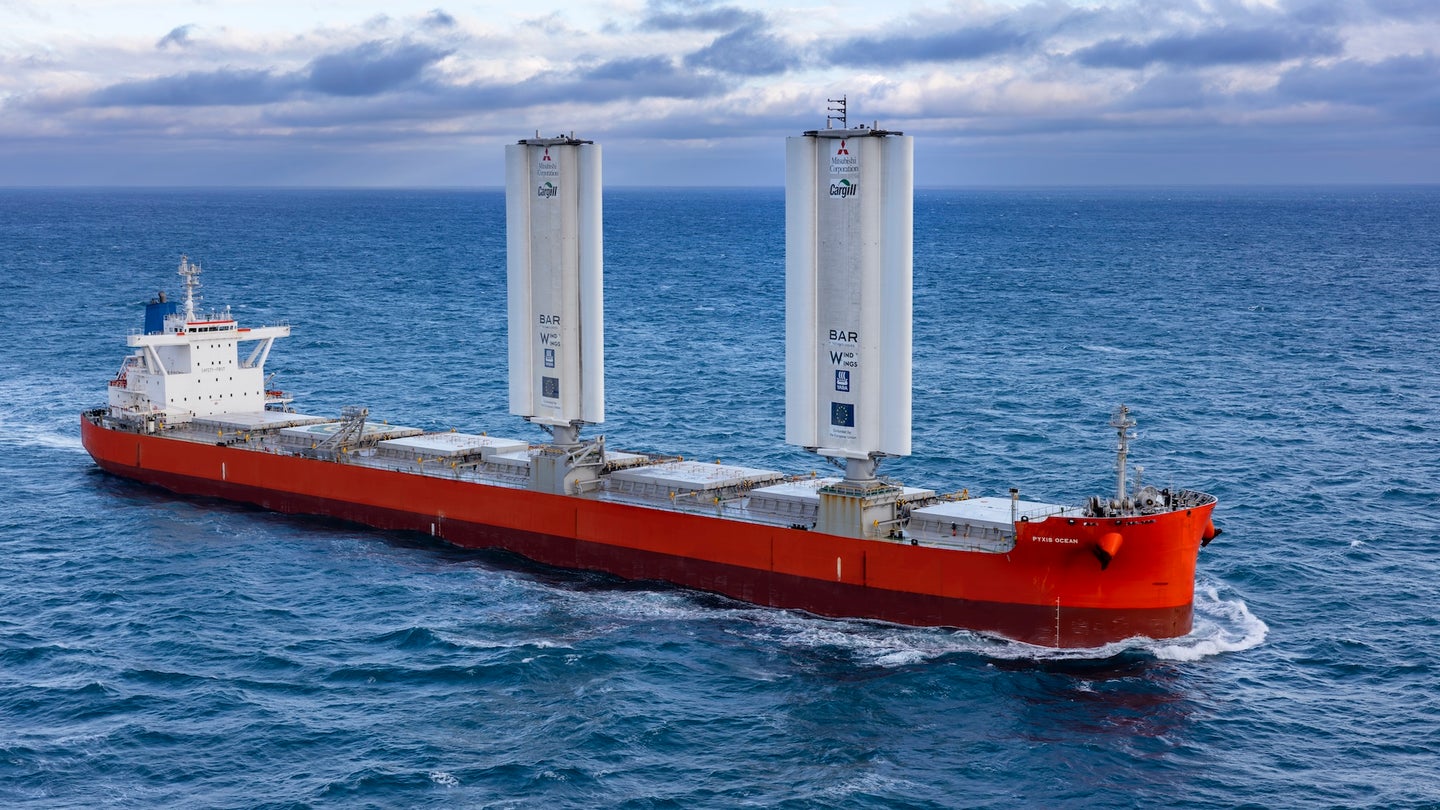
A shipping vessel left China for Brazil while sporting some new improvements last August—a pair of 123-feet-tall, solid “wings” retrofitted atop its deck to harness wind power for propulsion assistance. But after its six-week maiden voyage testing the green energy tech, the Pyxis Ocean MC Shipping Kamsarmax vessel apparently had many more trips ahead of it. Six months later, its owners at the shipping company, Cargill, shared the results of those journeys this week—and it sounds like the vertical WindWing sails could offer a promising way to reduce existing vessels’ emissions.
Using the wind force captured by its two giant, controllable sails to boost its speed, Pyxis Ocean reportedly saved an average of 3.3 tons of fuel each day. And in optimal weather conditions, its trips through portions of the Indian, Pacific, and Atlantic Oceans reduced fuel consumption by over 12 tons a day. According to Cargill’s math, that’s an average of 14 percent less greenhouse gas emissions from the ship. On its best days, Pyxis Ocean could cut that down by 37 percent. In all, the WindWing’s average performance fell within 10 percent ts designers’ computational fluid dynamics simulation predictions.
[Related: A cargo ship with 123-foot ‘WindWing’ sails has just departed on its maiden voyage .]
In total, an equally sized ship outfitted with two WindWings could annually save the same amount of emissions as removing 480 cars from roads—but that could even be a relatively conservative estimate, according to WindWing’s makers at BAR Technologies.
“[W]hile the Pyxis Ocean has two WindWings, we anticipate the majority of Kamsarmax vessels will carry three wings, further increasing the fuel savings and emissions reductions by a factor of 1.5,” BAR Technologies CEO John Cooper said in a statement on Tuesday.
The individual success of Pyxis Ocean is encouraging news, but that’s just one of the 110,000-or-so merchant ships in the world. On top of that, ports are currently designed to accommodate shipping vessels’ traditional proportions—that 125-feet of height added by WindWings could potentially complicate docking in many locations. According to Jan Dieleman, president of Cargill’s Ocean Transportation business, they’re already working to address such issues.
“Cargill is creating ways for all [wind assisted propulsion] vessels—not just the Pyxis Ocean—to operate on global trade routes,” they said in this week’s announcement, adding that the company has begun talking to over 250 ports to figure out the logistics needed to accommodate such ships.

Andrew Paul is Popular Science's staff writer covering tech news. Previously, he was a regular contributor to The A.V. Club and Input, and has had recent work also featured by Rolling Stone, Fangoria, GQ, Slate, NBC, as well as McSweeney's Internet Tendency. He lives outside Indianapolis.
Like science, tech, and DIY projects?
Sign up to receive Popular Science's emails and get the highlights.

IMAGES
VIDEO
COMMENTS
June 15, 2022. Catamarans aren't the most common ocean-crossing sailboats, but they're surprisingly safe and capable offshore. Catamarans are safe for ocean crossings. In fact, catamarans are often much safer than similarly-sized monohulls offshore. Safety comes from increased motion comfort, great stability, speed, and excess buoyancy due ...
Gunboat 62. gunboat_catamarans. An original performance catamaran cruiser from the iconic Gunboat manufacturer, the Gunboat 62 has truly cemented its place as one of the best catamaran sailboats to ever grace the oceans. Honestly speaking, this cat-inspired a whole range of other incredible boats including HH66 Catamaran and the Balance 526.
The best catamarans for sailing around the world include: Lagoon 42. The Fountaine Pajot Ipanema 58. Manta 42. Catana 50. Dolphin 42. Gunboat 62. These cats focus on speed, safety, and comfort for longer journeys. This article will show you the seventeen best catamarans for long journeys, and why they're the best.
So today we are going to present our choice based on the criteria mentioned above. One of the best catamarans for ocean sailing in 2020 is The Privilege 435. This is a long-distance, light weight cruiser produced in the Gold Coast area of La Rochelle. The Privilege 435 is a heavy-displacement multihull that has been around for almost 30 years.
Sailing back on the open ocean once again is a fantastic feeling. For a few months now, without Ruby Rose, we have felt a little lost. Taking this ocean read...
Catamarans are ideal for crossing the Pacific. The vessels are an ideal choice for any long journey, even crossing the Pacific, thanks to their size, large living area, high stability, and high speeds. The boat's length, which should be at least 30 feet (9.1 m) long, is a significant consideration. Crossing the ocean is no easy feat, even for ...
The Trade Winds route is the classic itinerary followed by most ocean-going catamarans. It promises crews the chance to sail around the world pushed by the wind, downwind, as long as they follow the rhythm of the seasons. It's possible to sail a catamaran from east to west, crossing three oceans and stopping off at some fantastic destinations.
The perfect sized catamaran for ocean sailing (including around the world sailing) is around 40ft; it is small enough to be sailed by one person but big enough to provide safety and speed. Of course, there are many variables to consider, and below we will discuss many of them. Before we can decide which one is perfect for our needs, we need to ...
A catamaran offers flat, even decks, wide, safe passages, and no climbing when having to move from bow to stern. Tips for Sailing a Catamaran. With its large area exposed to wind and its low draft, a sailing catamaran can drift off easily so anchoring should be performed as swiftly as possible, especially if the wind blows from the side.
1 Sail at higher angles to build up apparent wind speed (AWS) and boat speed. 2 Soak downwind as the apparent wind angle (AWA) surges forward with the acceleration. 3 Drive the boat back slowly ...
The safest cruising catamarans offer a good beam to length ratio, sail fast, and are over 42ft. These include the Manta 42, the Lagoon 450F, and the Catana 44. They are stable, waterproof, easy to handle in stormy weather, and feature a sturdy design. When boarding a boat, you expect to get to your destination safely, and with your bluewater ...
Something big has happened in ocean sailing. It could be the tipping point in the 34-year history of the Atlantic Rally for Cruisers , when multihulls move from minority element to ruling party.
1) Lagoon 42 sailing catamaran - From $365,000. Features: Self-tacking jib, 3 or 4 cabins layout, island bed in the master cabin, 6 to 12 berths, up to 4 heads, 2 45hp engines, up to 4 heads, 300L water capacity, 300L fuel capacity. If you value comfort over speed, then the Lagoon 42 is the best sailing catamaran for you.
Our 3,000-mile transatlantic crossing continues aboard the Bluewater 50 catamaran, "Zao". In Part 2, we set up the spinnaker off the Cabo Verde Islands to be...
With the advent of new technology the high tech necessary for ocean cruising catamarans is now affordable. The appeal of comfortable sailing without healing, of privacy only attainable with good separation of living and sleeping spaces, and a panoramic view with extraordinary deck space‐‐not to mention shoal draft… Catamarans have come of ...
We sailed through the Atlantic Ocean from Hampton, VA in the Chesapeake to the British Virgin Islands in the Caribbean on our Leopard 45 Sailing Catamaran. W...
Atlantic 47. The A47 suits short-handed fast ocean sailing at an approachable size. Lengthening it to 49ft allowed for an aft cockpit. It is available as a sloop or with White's patented ...
The reality of the daily life of two sailors in the ocean. How we ripped our gennaker and set the monster spinnaker. How we produce our own greens on an ocea...
As mentioned earlier, ocean waves don't affect catamarans as much as monohulls because, unlike monohulls, these boats don't heel or roll (or at least not as much). This is why it's easy to take a stroll either on the catamaran deck while under sail. The lack of heeling also makes it easier to handle the boat.
3. Bring the mainsail close to tack efficiently. You can tack efficiently by keeping the mainsail tight and sailing as close to the wind as possible. You must be able to do that without losing boat speed. Otherwise, you won't be able to tack. 4. Use the jib to help the bows turn better through the wind.
Stephen and I have made numerous ocean passages, some lasting only a few days and others several weeks at a time. The longest passage that we sailed was from Cape Town, South Africa via St. Helena Island to Fortaleza, Brazil in South America, and then Miami. It was a total of 42 days at sea. … Top Ten Tips for Ocean Passage Making Read More »
The ocean is a huge place—and unless you're sailing just to sail, it's always advantageous to shorten the time between destinations. Catamarans are fast—really fast. A typical cruising catamaran can reach speeds in excess of 20 knots in the best conditions, which is more than twice as fast as a typical monohull.
Discover the essentials of small catamaran sailing with this comprehensive step-by-step guide. Perfect for beginners looking to set sail on the open waters. ... or the ocean. Some catamarans are better for specific environments. Number of crew: Decide how many people you'll have onboard. Catamarans can accommodate different crew sizes, so ...
Choosing between a sailboat and a catamaran for your sailing adventures is a significant decision that depends on various factors, including your sailing preferences, experience level, budget, and ...
After six months sailing around the world, the numbers are in for the retrofitted 'Pyxis Ocean.' By Andrew Paul | Published Mar 14, 2024 10:00 AM EDT Pyxis Ocean sailing through the English ...
Aboard Ocean Diva, it's all about creating memories, sharing laughter, and having the time o..." Ocean Diva Catamaran | ⛵Friends who sail together, stay together! Aboard Ocean Diva, it's all about creating memories, sharing laughter, and having the time o... | Instagram